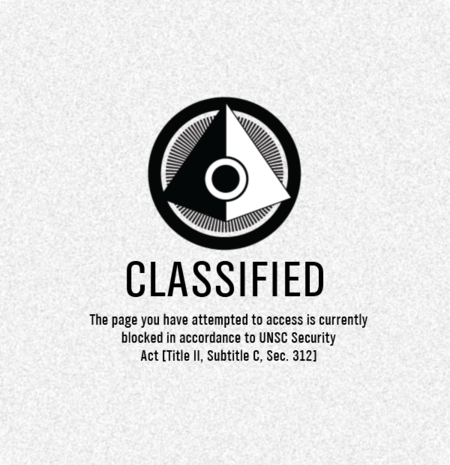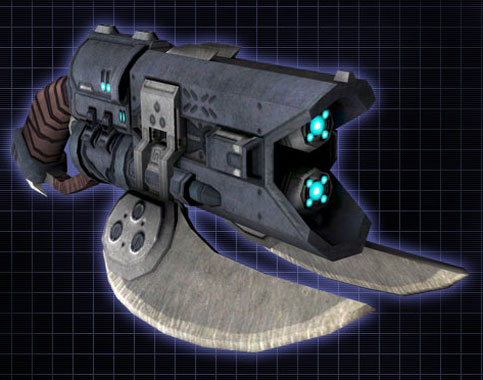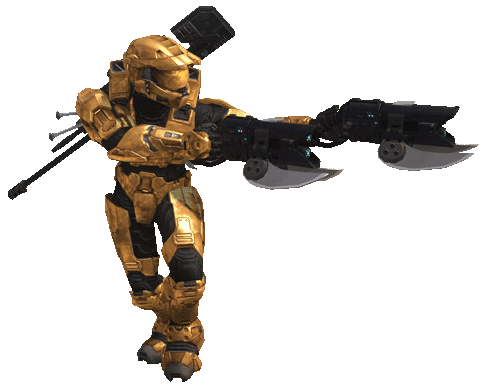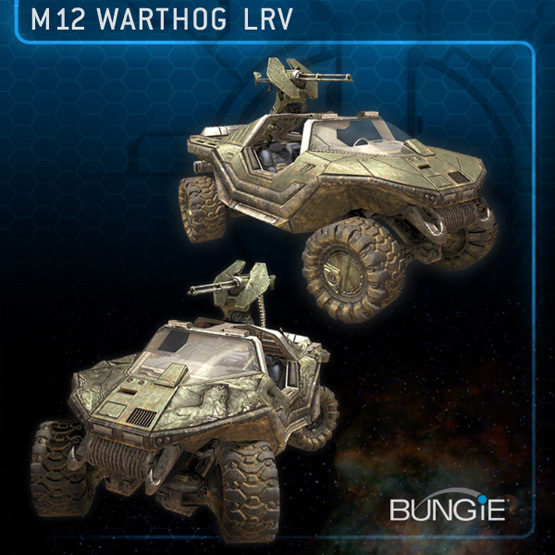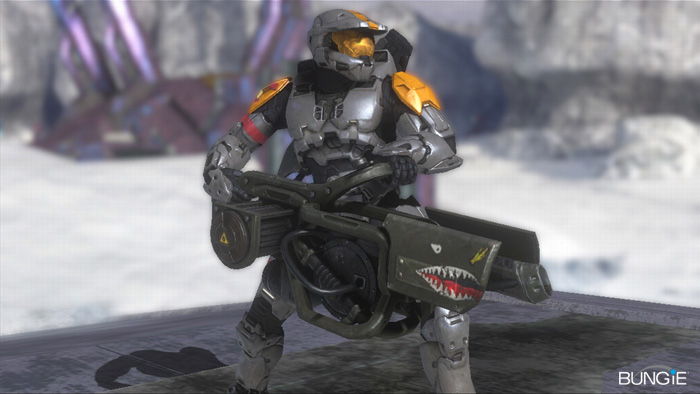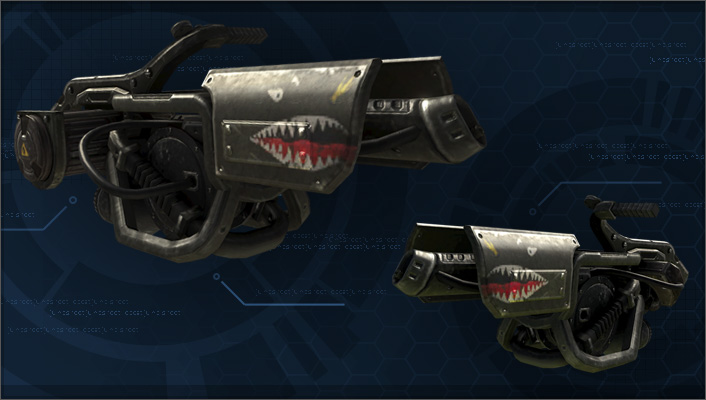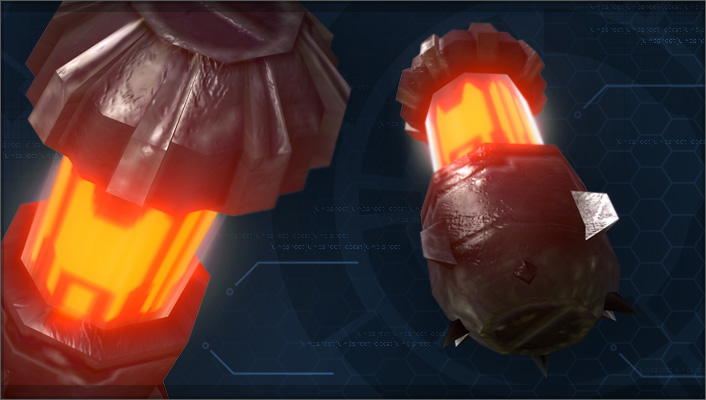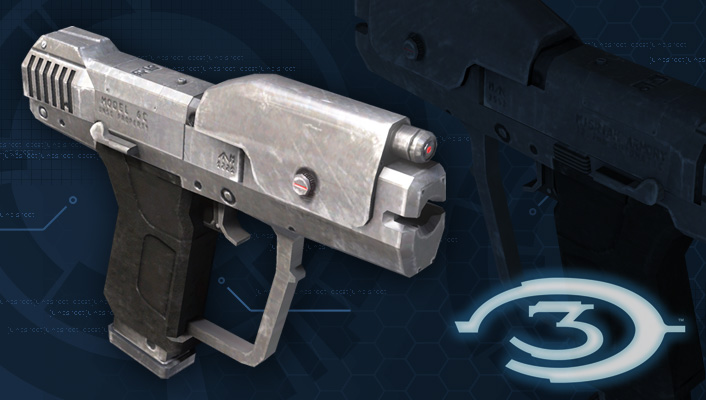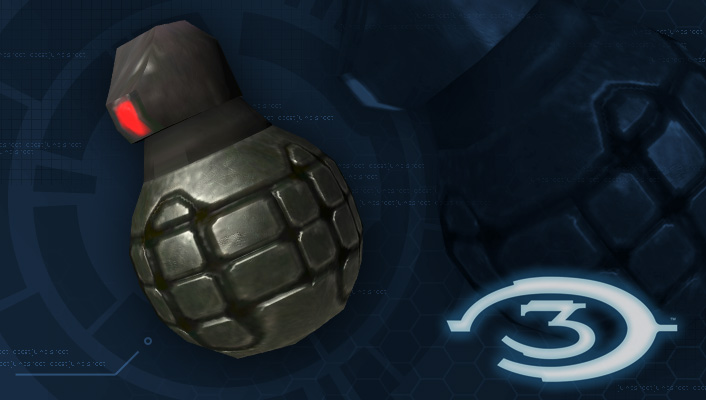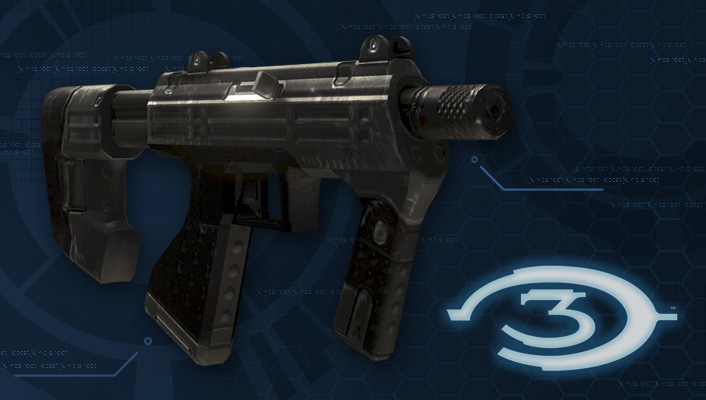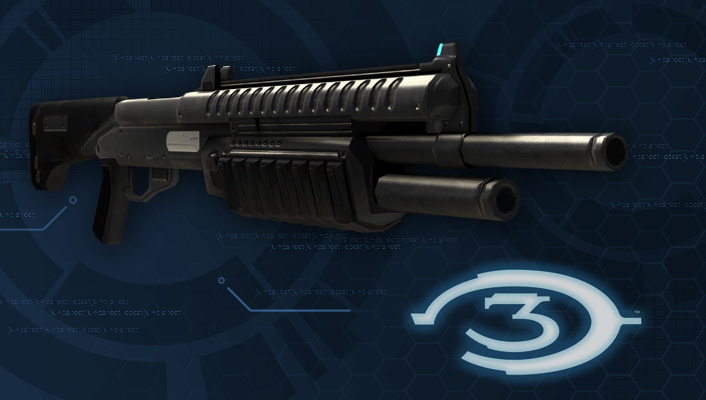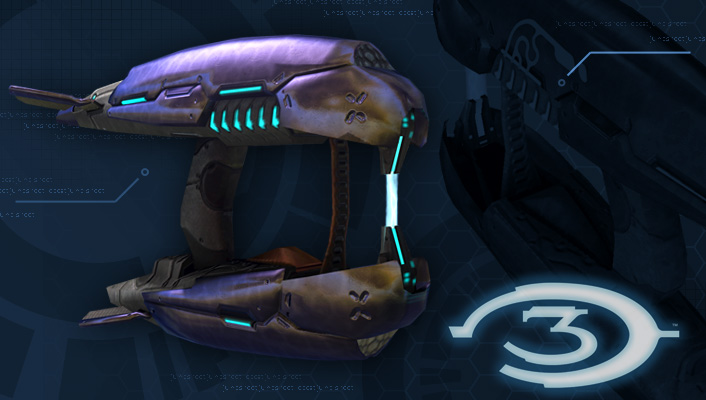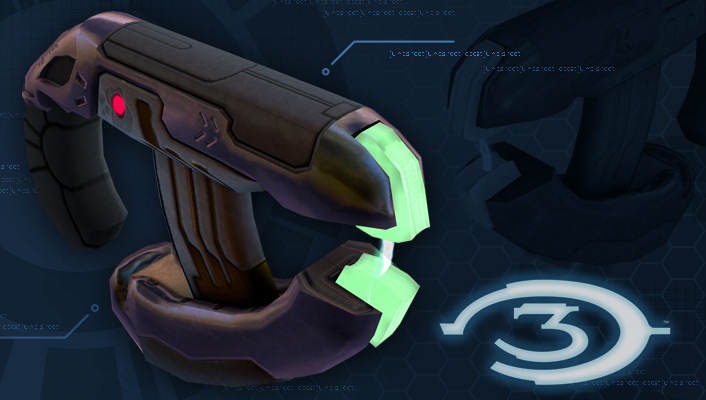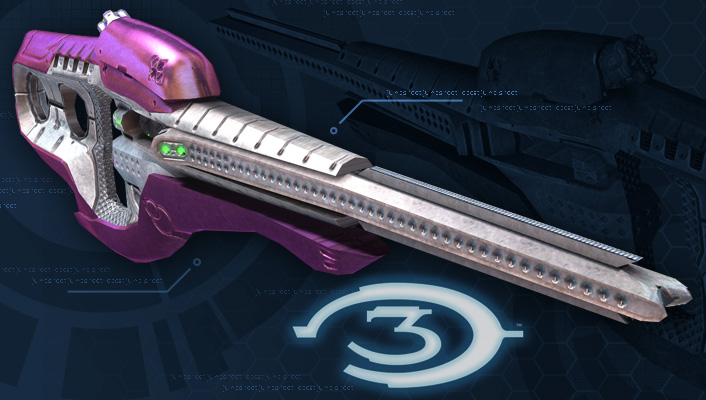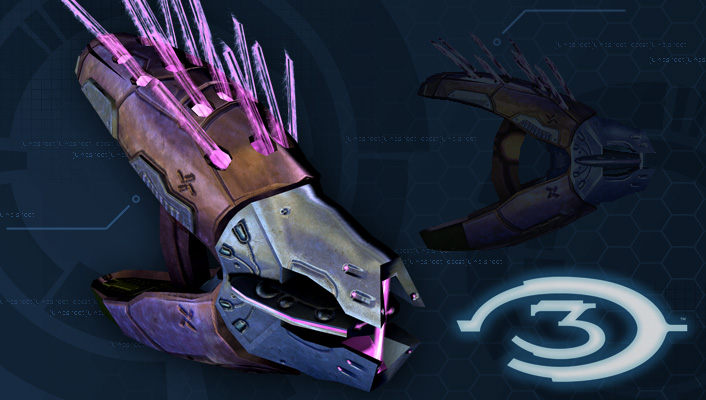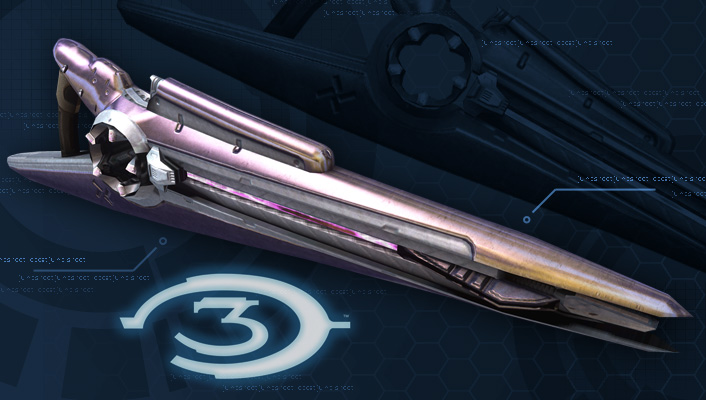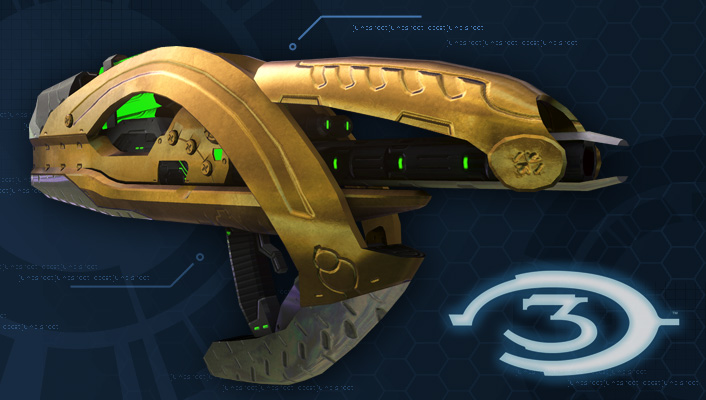Bungie.net/Halo Universe
Cette page rassemble les transcriptions des articles de la série Halo Universe, ainsi que d'autres informations concernant l'univers publiés sur Bungie.net.
Halo 3[modifier | modifier le wikicode]
C.Q.B.[modifier | modifier le wikicode]
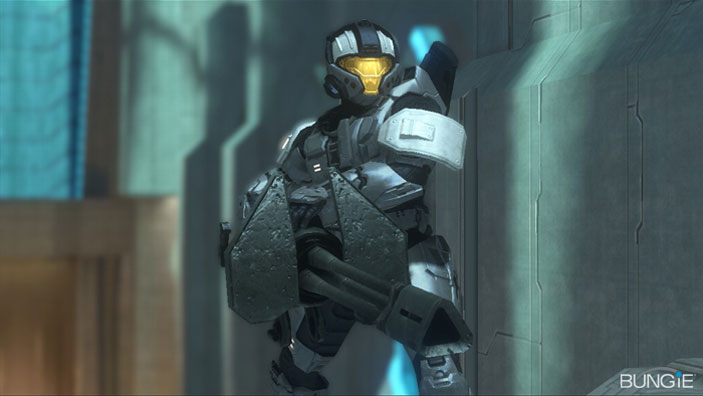
C.Q.B.: Close Quarters Battle
- The Mjolnir/C variant was developed and tested at UNSC facilities in Essen, Deutschland and Songnam, Hanguk, respectively; integrating feedback gathered from the Jericho VII Theater.
- Developed at Beweglichrüstungsysteme of Essen and tested at the Special Warfare Center in Songnam, the Mjolnir/C variant focuses on improving combat survivability and mobility.
- The intent with the Mark VI Mjolnir Powered Assault Armor/C variant was to improve survivability in close combat; specifically by looking at alternate methods of K dispersal and improving joint mobility.
E.V.A.[modifier | modifier le wikicode]
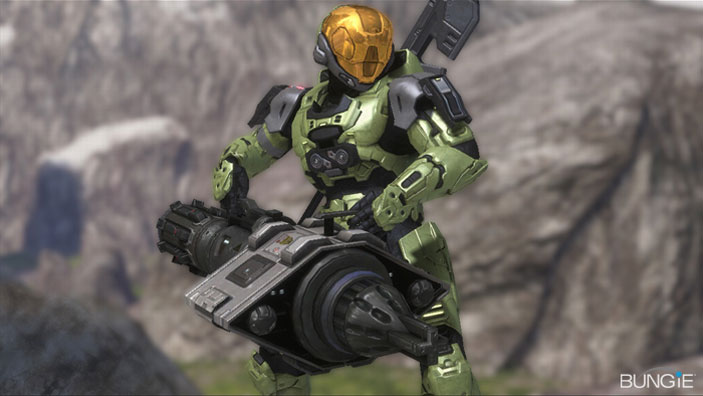
E.V.A.: Extra Vehicular Activity
- The MJOLNIR/V variant was developed and tested at the UNSC facilities in Lister, Aigburth, Ganymede; integrating feedback gathered from the Summa Deep Space Incident.
- Developed at the UNSC Low/Zero Gravity Testing Facility on Ganymede, the MJOLNIR/V variant focuses on increasing exoatmospheric endurance and improving mobility in zero gravity.
- In developing the Mark VI MJOLNIR Powered Assault Armor/V variant emphasis was placed on increasing exoatmospheric endurance and improving mobility in zero gravity without the use or thrusters.
Chopper[modifier | modifier le wikicode]
TYPE-25 Rapid Assault Vehicle "Chopper"
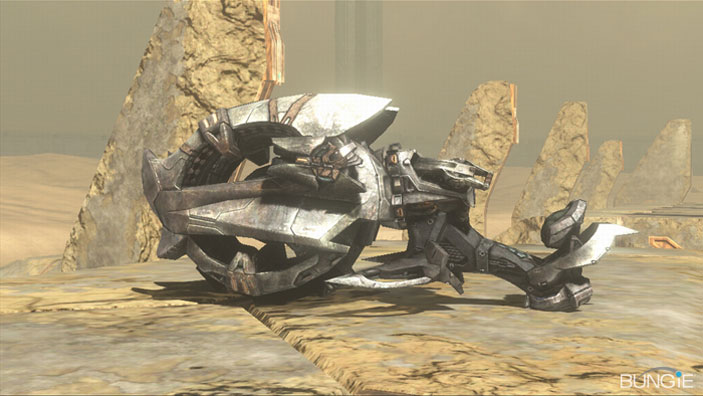
Description
The Type-25 RAV has become more common with the reappearance of the Brutes as frontline troops. Although it has not totally replaced the “ghost” as the primary rapid assault vehicle of the Covenant ground forces, it is usually piloted by higher ranking individuals. The vehicle is capable of momentary bursts of speed up to 120 kph (75 mph). The vehicle is armed with four (4) linked forward-firing light autocannons¹.
| Weapon Statistics | ||
|---|---|---|
| Weight: | 1 tonnes | (1.1 tons) |
| Length: | 6.4 meters | (21 feet.) |
| Height: | 2.9 meters | (9.77 feet) |
| Width: | 2.8 meters | (9.33 feet) |
| Power plant: | unknown | |
| Range: | 272 kilometers | (169 miles) |
| Top Speed: | 74 kph | |
| Main armament: | 4 x 35 mm autocannons (linked) | |
| Unit Replacement Cost: | N/A | |
Observations
Although this vehicle is significantly slower than many of those available to UNSC ground forces it is capable of nearly doubling its top speed momentarily through some unknown mechanism. The Type-25 RAV, while stoutly built, is very lightly armored and the driver is completely exposed except from the front where the vehicle’s prodigious engine provides more than adequate protection.
Remarks
“D’ya think they’re compensating for something? I mean, look at the size of the damn thing—it’s bigger than my first apartment.”
“It doesn’t have the room to accommodate a single passenger—and what do they do with their gear? Lash it on to the fenders?”
“They don’t have a lot in the way of places you can stow your gear—it’s basically a huge engine with a little bucket tied to it for you to stick your ass in. And big golf delta blades bolted to it, can’t forget about the blades.”
“All the markings are hand -painted. Well, at least they were on all the ones I’ve seen close up. I think [the Type-25] is more of a status symbol for the Brutes—or maybe a mount—than it is a just another piece of equipment.”
“Yeah, [WO SWG-FoR/SO N’thro] ‘Sraom basically confirmed that—said the riders held specific ranks outside the Covenant military hierarchy structure—that they’re more of a traditional unit like Cossacks or something.”
“They’re not very fast, but they’re like zombies—every time you turn around there they are breathing down your neck! Don’t help that they’re built like tanks, either.”
“With that big damn motor you’d think they’d really fly, wouldn’t you? I wonder if the Covenant romeo echo mike foxtrots slapped a governor on ‘em like our do with the warthog?”
¹ The use of the term autocannon here is not entirely accurate even though the weapon is self-loading and fires a large caliber (35mm) projectile.
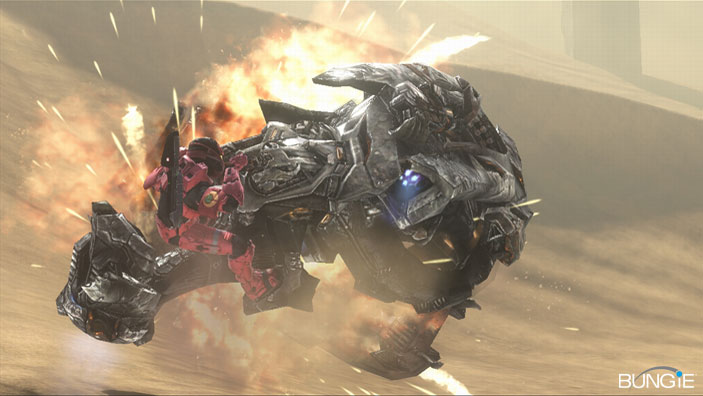
The Mongoose[modifier | modifier le wikicode]
With the invaluable help of Robt. McLees, Bungie formally introduces you to The Mongoose, the newest addition to the UNSC's ever-expanding arsenal with which to wage war against the Covenant.
Mongoose
Machines, Materiel and Munitions from the Human-Covenant Conflict, 2525 - Present
M274 ULTRA-LIGHT ALL-TERRAIN VEHICLE
Excerpt from long-term, in-field interview with the soldiers of E2-BAG/1/7.
M274 ULATV “Mongoose”
Top speed: 60 mph / 96 kph
Mpg: Between 45 and 65 (depending on load)
Power plant: 1000cc liquid-cooled, longitudinally mounted, four-stroke, hydrogen-injected ICE
Weight: 896 lbs / 406 kg
Description:
The M274 Ultra-light All-terrain Vehicle provides an alternate means of transporting messages, documents, and light cargo between units. It may also be used to transport forward observers, reconnaissance personnel and sniper teams. Its proven versatility has made it a vital asset to field commanders when used as an alternate means of communication.
Observations:
Overall soldiers are very appreciative and even fond of this asset. They believe the vehicle could benefit from greater power and the ability to tow a trailer. They would also like to be able to mount a crew-served weapon for personal protection.
Remarks:
“(The M274) is pretty nimble for its size; add to that the fact that it can do ninety plus kilo papa hotel over uneven terrain and you’ve got the ultimate commando hot rod.”
“Speed is the only protection this vehicle provides; it is unarmored, noisy, and prone to roll-over. It demands a level of skill from its operator that is impossible to expect from the rank and file during combat conditions. Those not qualified as expert need not apply.”
“That thing will go from zero to thirty in three seconds on anything short of snow covered ice.”
“The M274 doesn’t have a radio of its own, isn’t equipped with GPS, it doesn’t even have any gauges. The only piece of equipment more primitive is the crate it ships in.”
“The first thing everybody does is yank the front cargo cage – if you were to carry anything on it your forward visibility would be obstructed out to about six meters – that and less weight equals more speed… anyway it’s the first thing everybody does.”
“It’s a super versatile ATV in the tradition of the Sperry FCMMagLEV and Willys Jeep; without the former’s vulnerable drivetrain or the latter’s innards-rupturing suspension.”
“If they’re not gonna give us armor they should at least give us a mounted weapon. And you should be able to tow a trailer with it. And, god forbid, you try to ford bodies of water more than seven feet deep.”
“The M274’s range is excellent, and that’s even before you consider that you can double or triple its range that without severely impacting its max load – just a couple of jerrys of slop¹ and a carbon feeler.”
“Some fellas piss and moan about the M274’s lack of offensive capability, but it’s not meant to be an AFV! Still; with a brave fella riding pillion you should be able to put out enough disencouragement to break contact with all but the most bloodthirsty bravo kilo.”
“The (M274) is definitely the most Buddhist land-based motive system in the UNSC’s arsenal… I’ll just let that sit with you for a while.”
General Strategy:
Despite its size and limited offensive capabilities, the Mongoose is instrumental in many quick-striking strategies. It is decidedly difficult to damage in battle because of its speed and maneuverability delivered by its forgiving suspension and E-brake. Coupled with its speed, the capability to power-slide through turns gives the Mongoose unparalleled maneuverability on the battlefield. Drivers familiar with the M12 LRV Warthog should be able to easily transition into the Mongoose once they become familiar with its speed.
While susceptible to small-arms fire, the Mongoose is generally too quick to be affected by it. The Mongoose’s biggest foe on the battlefield will likely be the Spartan Laser. The Laser’s three second warm-up can make all the difference between a kill and a wasted shot, however. Specifically on big, hilly terrains like those found on Valhalla, the three seconds can give you enough time to over a hill, behind a base or behind cover of some other sort. The emergency brake on the Mongoose also helps you evade the Spartan Laser, if you’re able to time it properly. If they don’t see it coming, a slide in one direction or the other can help to evade the blast. As soon as you see the little red beam following you (and if you’re near enough, you’ll hear the weapon heating up), it’s wise to count off a second and then swerve the hell out of way to make as difficult a target as possible.
The Mongoose’s primary use is as an objective ferry. While you can use it to branch out quickly and gain control of key areas, ultimately the brass believes that the Mongoose’s most appealing trait is its ability to carry the driver and a passenger holding an objective. A driver and passenger can go from base to base or two assailants can grab a Mongoose laying around at the enemy base to transport the flag back to their home base.
Usage Scenario:
Example - Valhalla CTF
Located at each base station on Valhalla are two Mongoose units. In a typical encounter, both might be ignored initially while your team takes off on foot, through the Mancannon or even in a Banshee. Ignoring them is a rookie mistake however, especially in objective-based scenarios. While attempting to capture say, an enemy flag, sending out two Mongoose riders with passengers can be a brilliant tactical move.
Head through the narrow river gully, or up through the rocks (the Mongoose is slim and agile and can fit through gaps that would stop a Hog dead) and head straight at their base. Rear passengers both exit Mongoose simultaneously at the east and west sides of the enemy base and hop up over the wall to grab the flag. By the time one of them makes it back over the wall, one vehicle can have safely looped around the base for a pick up right there, or alternatively, the other ‘Goose can head straight back to the Mancannon landing spot and pick up the flag carrier there.
Example- High Ground 1 Flag
Situated behind the command center within the base at High Ground are three Mongoose units. While defending one’s flag, the boldest of squads may actually open their protective gate. All three Mongoose vehicles will come screaming out from behind it to gain control of the map in a surprise assault. Send one Mongoose, with or without passenger, to each area of interest outside the base. Striking with quick and overwhelming force is the key, simply running down targets or snatching and grabbing the items that you want and returning to the base with due haste.
The surprise assault should take the enemy off-guard and with any luck they won’t be prepared to defend against it. The strike is designed to detract from the opposing force’s offensive capability and this will be accomplished even if only two of the three Mongooses achieve their task. By the time the enemy has a chance to regroup and counter, the Mongoose vehicles will be long gone.
Example- Valhalla Slayer
Again, in each base of Valhalla is a pair of Mongoose vehicles. While other vehicles spawn at the bases (currently Warthogs, Banshees and Wraiths) it is often smartest to take a Mongoose or two out into the field to establish an early foothold in the battlefield. The middle of Valhalla is an important area to control and sending Mongoose vehicles out to control the area by the downed Pelican and/or the turret across the stream from the Pelican can set the tone for the battle.
Once control of the middle of the field is established, you have an opportunity to bring up the support and assault vehicles. Station the Wraith on top of the hill and use the Banshee to cover it and counter their Banshee. A Warthog could charge out around this time and go on the offensive at or around the enemy base. A sniper should also be able to move up to the middle of the map while the vehicles dominate and help to pin down the enemy at their base.
1 Slop is military slang for Nanoreagent Hydrocarbots - a suspension of nanomachines that renders nearly all carbon heavy matter into usable fuel for the UNSC’s ubiquitous internal combustion powerplants.
MA5C Assault Rifle[modifier | modifier le wikicode]
Another delve into the world of Halo 3 vehicles and weapons - this time Robt. McLees assists us in a tour of what's soon to be everyone's favorite spawning weapon - the MA5C Individual Combat Weapon System, otherwise known as the Assault Rifle.
MA5C Assault Rifle
Excerpt from long-term, in-field interview with the soldiers of E2-BAG/1/7.
MA5C Individual Combat Weapon System
Official designation: MA5C
Length (o/a): 88 cm (34.6 in.)
Length (barrel): 60.7 cm (24 in.)
Weight (empty): 3.8 kg (8.378 lbs)
Weight (loaded): 4.1 kg (9.05 lbs)
Cartridge: 7.62mm x 51 FMJ
Max. effective range: 300 meters (984 ft)
Muzzle velocity: 905 m/s (2970 f/s)
Magazine capacity: 32 rounds
Rate of fire: 750 – 900 rnds/min
Unit Replacement cost: 1686.00
Description:
The MA5C 7.62mm rifle is an air-cooled, gas-operated, magazine fed weapon designed for automatic fire. The weapon has an attached electronics suite that provides information on rounds remaining in magazine, compass heading, as well as several other "housekeeping" functions.
Improvements over the MA5B include:
- a heavier barrel with a 1 in 7 twist; - a redesigned cowling to house the electronics suite that reduces weight and increases pointability of weapon; - a redesigned handguard which is sturdier and provides a more positive grip.
Observations:
Soldiers are very satisfied with this weapon. It performed well in a variety of environments especially given the perceived delicacy of the attached electronics suite. The general consensus is that every infantryman wants a MA5C.
The most significant negative comment was reference to the MA5C’s lack of a secondary weapon system.
Remarks:
“The (MA5C) is the workhorse for us ground-pounders. Just holding it makes you feel like God’s own anti-son-of-a-blam!-machine.”
“I have slogged through snow and mud and sand with my (MA5C); even got dumped into an open sewer with it and it has never given me a bit of complaint. I trust it like I trust my own arms.”
“The MA5C is built like a brick outhouse with Venetian blinds. You can pound on a mike foxtrot with it like it was a sledgehammer.”
“For every time I’ve felt outgunned by those alien bastards shooting blobs of energy at me I have felt like death himself watching their bodies come apart under a hail of lead from my (MA5C).”
“The romeo echo mike foxtrot’s decision to mechanically reduce the (MA5C)’s magazine capacity by nearly half is pretty frustrating; even if their data was showing that jamming because of loss of spring strength was becoming an issue.”
“The only thing I can think of that would make the (MA5C) any sweeter would be an under-slung shotty or a forty mike mike.”
“Next time I’m dirtside I’ve gotta try and find a red filter for the flashlight; slipspace travel screws with mail-order something fierce.
Your Standard Point and Click Interface
There is much to be said about the MA5C with regards to tactics and strategies. The weapon’s power can be described as being somewhere between the original MA5B Assault Rifle and the BR55 Battle Rifle. Obviously it shares more with the MA5B, though as we'll demonstrate, aesthetics aren’t everything. It shares more with the BR55 than one might suspect. The clip capacity has been reduced to the 32 rounds that you’re used to seeing in the BR55, but the rifle’s range has been slightly improved over its predecessor to make it more formidable as an Assault Rifle. It also deals greater damage per round than did the original MA5B
At close range, the MA5C can be used to rain hurtin’ bombs upon one’s adversary. Fully shielded Spartans can take two blows from the rifle before dropping. Strategically, however, peppering your target with a healthy amount of rounds (ten, give or take), followed by a crushing blow from the butt of the rifle will score a kill nearly every time.
At medium to close-range, you’ll want to simply unload and put as many rounds into your target as possible. If you’re looking for a quicker kill, or if you have multiple targets, you’ll want to hit them with a 'nade first to drop their shields and then clean them up with a few sustained bursts from the rifle. Often, when engaging multiple hostiles, it will be wise to try put nearly all of your clip into one target and after that one’s been dispatched, you’ll want to put a frag on the ground beside your next opponent and proceed to empty the remainder of your clip, the last seven or so rounds, into your target to finish off the kill.
Many new recruits will succumb to the temptation to lie on the trigger for targets of all ranges. Hopefully, over time they’ll learn from the veterans in their squads to pulse the trigger. Pulsing the trigger gives you a significant advantage with targets at medium range. It can be the difference between needing to reload, versus only needing a single clip to take down your target. The more disciplined soldier will win that battle every time.
Compliments of the Chief
The Assault Rifle is easily one of the most versatile weapons in the UNSC’s arsenal; fittingly so, as it is the standard-issue weapon for infantry forces. Due to this versatility, the AR is complimented by many of the UNSC’s other weapons as either the primary means to a kill or in a secondary role as the fallback weapon.
Battle Rifle and Assault Rifle
This combination might be one of the safest available to you in the field. The Battle Rifle will enable you to manage targets at medium to long-range while the Assault Rifle allows you to handle short to medium-range targets. The combination really just enables you to kill everything in your path. There’s no greater strategy to it, if you’ve got a BR and an AR then you’re likely on the offensive trying to cut a path into the enemy base. This well-balanced combo protects you in the open field from pretty much anything except skilled snipers at great distances and heavy vehicles. Like any mid range weapon, its greatest weakness is its relative ineffectiveness at close quarters against the likes of a Shotgun or sword.
Sniper Rifle and Assault Rifle
If you’re setting up roost with the Sniper Rifle somewhere out of the way and/or in defense of your base, then you will typically grab the Sniper and a BR. However, if you’re going on the offensive with the Sniper Rifle in an attempt to gain control of the middle of an area like Valhalla, then the Assault Rifle may well be a better choice to compliment the sniper. While the BR gives you a chance to clean up targets that you only hit once with the sniper, the AR gives you a chance to defend yourself in a relatively tight space. Valhalla, while being a large, wide-open area, has a large hill in the middle of it. When setting up atop this hill, the AR can be more affective in supporting your sniping because there are multiple angles of approach and it’s very likely that someone will get close enough to bring the fight in to a close range, which people generally prefer to do to a sniper. The AR is easier to handle and deadlier at close ranges than is the BR, which leads us to recommend it in such a scenario. Fast pulsing is also a good way to steal kills from your buddies.
Shotgun and Assault Rifle
This is an excellent pair of weapons to set up a defensive stand. This combo will be very effective in tight quarters, the likes of which you might find in the bunkers of the High Ground base. When defending such an area, the enemy rarely has a chance to avoid the initial Shotgun blast. However, if they’re smart, they started backpedaling as soon as they saw the business end of the Shotgun and may possibly be out of the its range by the time you’re ready to pump another serving of buckshot into his chest. In this instance, the Assault Rifle picks up the slack. By firing controlled bursts at the already wounded target, the AR will make quick work of the job. In the event of an assault by multiple targets on an objective such as a flag, it will be wise to go with the AR as your primary, put a grenade into the approaching enemies and then tear into them with the AR from a distance.
Spike Grenade[modifier | modifier le wikicode]
Robt. McLees again contributes to our latest preview of a new Halo 3 weapon. Read on for the UNSC's latest intel on the Brute's grenade of choice: The Type-2 Antipersonnel Fragmentation Grenade - or spike grenade, for short.
Spike Grenade
Excerpt from long-term, in-field interview with the soldiers of E2-BAG/1/7.
Type-2 Antipersonnel Fragmentation Grenade
Official designation: Type-2 Antipersonnel Fragmentation Grenade Length (o/a): 91.4 cm (36 in.) Weight: 1.93 kg (4.25 lbs) Filler: Unknown Killing radius: 3 meters (10 ft) Casualty radius¹: 11 meters (36 ft) Unit Replacement cost: N/A
Description:
The Type-2 is the standard antipersonnel fragmentation grenade of the Covenant heavy infantry. It resembles the early 20th century Model 24 Stielhandgranate superficially, which has lead to it being called “potato masher”. It has also acquired the monikers “spike grenade”, “table leg”, and “nail bomb”.
Observations:
The directional explosive characteristics of the Type-2 makes it particularly suited to defensive and antivehicle use.
Remarks:
“It’s like a table leg with machetes bolted to it. Who the hell makes a weapon like that? Did those guys actually get up into space on their own?”
“It’s not as heavy as it looks, but it’s still like trying to throw a softball bat.”
“When you decide to throw one of these things make sure to tell everyone around you, ‘cause they are dangerous all the way there.”
“Those things ain’t made to wound anyone – to make you use up time and resources treating casualties. They were designed to make you die screaming.”
“The casing is constructed of an unusual porous metallic compound. Shrapnel from the Type-2 reaches a temperature of approximately 270 to 315ºC and retains that heat for upwards of seven seconds. By design.”
“I’ve heard guys say that there’s nothing as scary as seeing one of these slam into a wall – or a man – you’re standing next to. Well, those guys have never seen a whole squad of baby kongs huckin’ ‘em in their direction at the same time – ‘cause that is some scary ****.”
“It’s like a shotgun that shoots flaming chainsaws at mike foxtrots – except you throw it.”
¹ The explosive force and fragment distribution of the type-2 APFG is channeled into a narrow cone perpendicular to the surface it strikes. The mechanism by which the explosion of the type-2 is directed is similar to that of the M383C Linear Shaped Charge Demolition Kit.
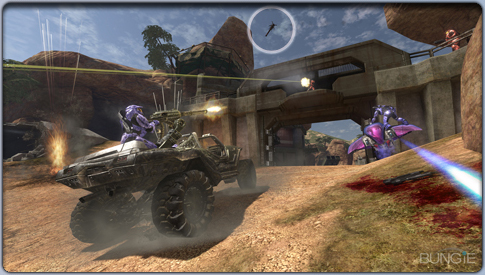
What, Like a Spider?
In the UNSC’s limited encounters with the spike grenade, we have learned much of its tactical applications both through contact with the Brutes and field tests of our own using discarded equipment. The quills of the spike grenade seem to be able to grip almost any surface upon which it’s been tested. This includes rock, glass and even some Covenant shield systems, unlike the plasma grenades which we have encountered before. The other feature unique to this grenade is its directional blast. Our researchers have discovered that the directional blast of the grenade is not designed to come out of one end or the other, but instead is relative to the surface against which it rests. If thrown against a perfectly flat wall, the grenade’s blast will disperse perpendicular to the wall.
The Brutes have proven the strategic advantage of the grenade time and again in their recent activities on Earth. In the type of street to street urban combat we’ve been forced to participate in, and the close quarters therein, the Brute grenade is a ferocious problem. Its most useful application thus far has been to throw it directly across from an enemy, or rather where an enemy will be. The blast is typically enough to kill a marine or grunt but conversely, it will heavily damage a Brute.
Applying the grenade directly to an enemy will invariably result in death. While the initial wound, akin to being run through by mini-baseball bat with nails sticking out of it, is survivable, the device arms upon impact and invariably detonates before it can be extracted from the body.
Laces Out
The application of the spike grenade will at first come naturally to UNSC forces that have experience with the plasma grenade and its capacity to stick to the enemy. This element of its feature set will not take much getting used to. The main difference between the spike grenade’s sticking ability and the plasma grenade’s is the fact that the spike grenade will still maintain its directional blast as opposed to the plasma grenade’s spherical blast. If you stick an enemy with the spike grenade you will want to get away from the blast as quickly as possible. Spartans have made a habit of sticking the enemy and then jumping straight over them to avoid the blast. Our more tactful marines will stick a brute and immediately find cover. If you have multiple targets, it may be advantageous to stick the rearmost of them and let the blast claim the targets in front of it, meanwhile shielding you from the blast.
There are many scenarios in which the spike grenade can be used more like a claymore mine than the grenade designation we’ve given it. The base at High Ground presents several such opportunities for the defending force. The many flat surfaces and 90 degree agles make it an ideal environment in which to set up a trap for an approaching opponent. One can, for example, use the corridors of the base to trap opponents in the line of the spike grenade’s fire. Two such corridors leading in through the bunker are quite narrow and throwing a spike grenade onto the wall as an enemy passes, can be just as effective as placing a frag grenade right at their feet. It’s better than tossing a frag however, because you don’t need to calculate for the bounce - and better than a plasma because you don’t need to be precise enough to hit a moving target. It is certainly a weapon benefitting the smarter and more patient soldier willing to wait for the right moment to strike.
Another of the spike grenade’s claymore-like features is its ability to cover an individual’s retreat. When falling back to better cover in the battlefield, soldiers can toss the spike grenade at passing walls and objects in order to slow the advance of pursuing foes. This can apply to any area but one specific scenario in which it has been particularly useful has been in the Covenant facility at Snowbound. The shield doors that are riddled throughout the base do not permit active projectiles or armed grenades to pass through them, and therefore the spike grenade sticks to this as it would any other surface. Our soldiers have found this particularly useful in enemy encounters, as they stick a spike grenade to the door, pass through and then turn around to watch the spike grenade take its toll on the following enemy.
Spartan Laser[modifier | modifier le wikicode]
The latest in our series of Halo 3 weapon and equipment slots, the Spartan Laser is one of the most exciting new weapons in the UNSC arsenal. Read on for new info on what may be the most destructive weapon you will ever wield.
Spartan Laser
Excerpt from long-term, in-field interview with the soldiers of E2-BAG/1/7.
Weapon/Anti-Vehicle Model 6 Grindell/Galileian Nonlinear Rifle (W/AV M6 G/GNR)
Official designation: M6 G/GNR
Length (o/a): 98.8 cm (38.9 in.)
Length (barrel):
Weight (empty): 19.07 kg (42 lbs)
Weight (loaded): 20.4 kg (45 lbs)
Cartridge:
Max. effective range:
Muzzle velocity: 299792458 m/s (983 571 056 f/s)
Magazine capacity:
Rate of fire: semi-automatic only
Unit Replacement cost: cR. 218000.00
Description:
The M6 G/GNR is a REDACTED type laser. It can be used in both anti-vehicle and antipersonnel roles. The weapon has an integrated Wyrd III optics suite (smart-linked).
Observations:
Soldiers appreciate the range, accuracy, and target effect. They view the effect of “our own directed energy weapon” as a combat multiplier due to the psychological impact on combatants that viewed the destruction of the target.
Remarks:
“The M6 is a splendid special application anti-vehicle slash anti-materiel weapon – even if it is a little on the heavy side. The imprudent use of this weapon in the antipersonnel role, which is to say, against non high-value targets – grunts or drones for example -- is strongly discouraged.”
“I engaged an enemy chopper at a range of REDACTED meters. The target immediately erupted into flames. Both vehicle and rider were eliminated.”
“My spotter positively identified the local bravo kilo sub-chieftain. I engaged the target at REDACTED meters. The shot burned an approximately REDACTED diameter hole through the target and severely damaged the mauler he had just dismounted.”
“The M6 is one of those rare systems that simultaneously boosts morale, degrades the fighting spirit of the enemy and actually performs admirably as a weapon.”
“Because of their cost and complexity the (M6 G/GNR) and like systems are not going to find widespread adoption. They will remain specialist weapons, at least for the foreseeable future.
“During action on grid REDACTED, REDACTED a pair of Banshees were harassing our left flank. Our anti-air element was suppressed so I opened a request for fire support. A beam struck the trailing Banshee. The canopy separated from the fuselage and the pilot spilled out right before it burst into flames and pin-wheeled in.”
“The shot entered the rear of the Phantom, killing three Brutes and injuring two others.”
“The equipment required (PP-16979/AM-Sh) to recharge the non-removable battery (BA-53635/PLMD) for the M6 G/GNR does not and never has shipped with the weapon – and for some dang reason I’ve never seen them ship at the same time. Do people not realize that they are two different pieces of equipment?”
This End Toward Enemy
The Spartan Laser is one of the most powerful weapons available to our UNSC personnel on the ground. Heavy to lift, slow to fire and incredibly powerful, the laser's main purpose is to serve as an anti-vehicle weapon. It is capable of bringing down virtually any vehicle that you can expect to encounter on the battlefield. Along with its effectiveness against vehicles, the Spartan Laser's precision and power also make it a potent anti-personnel weapon, capable of scoring a kill with a single hit anywhere on an enemy.
The laser requires a quick three second charge before it’s able to fire, at which point it lets loose a red beam of light for a split second. Anything in the path of the laser will be destroyed, multiple enemies, vehicles and objects. Because of this you must be particularly careful of friendlies in the area, as they can be wounded or killed by exploding vehicles or the laser itself.
The Spartan Laser can be effectively implemented in the battlefield in numerous roles. It is an excellent defensive weapon, able to destroy reconnaissance, assault and support vehicles from great range, as well as demolish any foot soldiers. Offensively it can be used to compliment an assault of an enemy base, destroying enemy vehicles so that they are unable to mount a serious counter-attack to a Warthog assault as well as taking down critical targets from a distance.
Seeing Red
Valhalla
The Spartan Laser has seen extensive use in the field at Valhalla, where it is available atop a hill in the middle of the region. As is well-known of Valhalla, by this point, control of this hill is imperative and can decide the battle. A skilled Spartan wielding the laser can effectively suppress an enemy team of four for a short period of time from that position. Whether it be sniping personnel as they shoot off of the mancannon or destroying vehicles attempting to escape, the Spartan Laser is instrumental in the control of the mid-field of Valhalla.
The fear factor of this weapon has also become part of its feature set. There’s nothing quite like a small red beam of light bearing down on your vehicle to dissuade you from leaving a safe area. Because the weapon doesn’t discharge a significant amount of energy until it is actually fired, you can simply “paint” enemies instead of expending a shot on them. It serves all the purposes of suppressing fire without ever needing to fire an actual shot, since you only have a limited number and you'll want to be careful with them.
High Ground
Within the base at High Ground, the Spartan Laser is available atop the camouflage tower overlooking the beach. Because the assaulting Warthogs and Mongi will not likely come until the gate is open, as well as the likelihood that the enemy team’s sniper will be focused on that camo tower to start with, it’s not always worth rushing. Once the attackers have the gate open, however, the laser will be your best hope for taking down an incoming ‘hog before it reaches the base, if you’re in position.
If the attacking team gains control of the Spartan Laser on High Ground, its greatest advantage to an attacking team is the fact that it is in your hands. You can attack the base without worrying about being destroyed before ever getting inside. Because the base is a tight-quarters area, attackers will find the laser most useful to cover their retreat back to the beach with the objective. The defending team may have a Mongoose and/or a Ghost available to them to pursue the attacking team, but the laser will put a quick end to that as well as those charging out from the gate who don’t notice the thin red beam light tracking them.
The Spiker[modifier | modifier le wikicode]
Another in our continuing and in-depth looks at the weapons of Halo 3. This time we expose a dual wieldable weapon, designed exclusively for Halo 3. The Brute Spiker. A nasty, vicious, shredding horror used primarily by Brutes. Learn to love it now. And make sure you have QuickTime installed...
Brute Spiker
Excerpt from long-term, in-field interview with the soldiers of E2-BAG/1/7.
Type-25 Carbine (Spiker)
Length (o/a): 81.7 cm (32.17 in.)
Length (barrel): 25.4 cm (10 in.)
Weight (empty): 6.4 kg (14.2 lbs)
Weight (loaded): 7 kg (15.5 lbs)
Cartridge: Unknown
Effective range: 40 meters (131 ft)
Muzzle velocity: 76.2 m/s (250 f/s)
Magazine capacity: 40 rounds
Rate of fire: 480 rnds/min
'Unit Replacement Cost: NA
Description:
The type-25 carbine is a magazine fed weapon designed for automatic fire. The weapon has two tungsten-alloy bayonet-type attachments.
Observations:
This weapon resembles our technology more closely than it does the other weapons in the Covenant’s arsenal. It performs admirably in a variety of environments; it is a widely held belief that the weapon could sit unattended for several weeks in an active latrine and still operate as issued with no maintenance performed on it. Unfortunately this is not far from the truth.
Though it was first observed over a quarter century ago this weapon has not been seen in the hands of front line troops until just recently. Over the years it has garnered the nicknames “Spike Rifle”, “Spiker”, and “hatchet gun”.
Remarks:
“Even though them spike rifles are really heavy I still wish there was some way to retrofit a full stock onto ‘em.”
“Recoil isn’t as bad as you might expect, but not because of any sophisticated dampening system – it’s because the damn things weigh so much.”
“I saw the baby kong go dry so I moved in with my shotty, well that’s the last time I’ll be doing that, huh? Damn cleaver-bayonet-thing went right through the shotty and cut my arm off just above the elbow. Only reason I’m still here is because of, well you know, because of him.”
“Every action requires exaggerated movement; cycling the bolt, seating a magazine, charging the chamber. Even squeezing the trigger takes quite a bit of effort. And it isn’t all that surprising considering the disparity in size of our two species.”
“Bravo kilos sure have a thing for sticking blades on their equipment, don’t they? I bet their mess kits’ve got three knives.”
“The projectiles fired from this weapon seem to be made out of the same material as the spike grenade’s casing. Wounds caused by this weapon are horrifying.”
“Spike rifles always have a weird sorta burnt hair smell about them. And you know you’re heading towards a firefight where they’re bein’ used if it smells like a barbeque gone wrong.”
Using the Spiker in the Field
Off-planet fighting brings with it some of the disadvantages of interstellar flight. Notably, the expense and difficulty of transporting large amounts of weaponry and ammunition. Unlike our ancestors in the preceding centuries, we cannot afford the luxury of ignoring or destroying enemy materiel or equipment. We field train even the most basic infantry in the “art” of utilizing found materials and weapons. A dead foe can be a treasure trove of equipment for a properly trained Spartan.
Only recently have we encountered the so-called Spikers (Type-25 Carbine per the field manual), however, as the Brutes, in the wake of the Elite insurgence, assert their power and implement Brute strategies and weaponry on the field of combat.
Brute Spikers are, and the pun is unavoidable, brutally effective. In field, they have similar penetration and lethal range to SMG pistols, but there are a few vital differences.
Unlike SMGs, there’s little recoil, and therefore almost zero “rise” when using them in their default, full-automatic setting. This actually makes them a little more efficient and accurate than the SMG in dual-wielding situations, since you don’t have to adjust aim to stay centered.
Like SMGs, pulsing the trigger rather than squeezing it into fully automatic mode, will result in more accurate shooting over distance. The spikes have a very large spread when sprayed in fully automatic mode. Larger even than the SMG.
More vitally, the spikes don’t deform on impact if shot at close surfaces at an angle. Shoot head on, and they crumple, but angle that shot and you can deflect, with predictable accuracy, deadly, shredding rounds that basically lose none of their efficacy.
As you can imagine, in very tight confines, the effect can be used deliberately to injure or weaken a player who thinks they’re in safe cover. They might also relax their guard, believing that your aim is catastrophically off, or that you’re targeting another opponent.
In tests at High Ground, we’ve found that the Spikers can be used effectively at a medium distance to pick off enemies who’re often confused (and panicked) first by the sound, but then have difficulty recognizing what weapon is being used against them.
The SMG comparison becomes especially relevant in close-quarters fighting however. The Spiker ammunition does terrible things to human flesh, and will penetrate shields and armor with ease. Files are being updated constantly on this and other brute strategies. More and more we are discovering that Brutes are as great, if not a greater threat in combat than our previous problem, the Elites.
The Warthog[modifier | modifier le wikicode]
This week, we take a look at what's probably the all time favorite vehicle in the enitre Halo universe. It's the Warthog.
M12 Warthog
Description
The M12 is primarily used in a scouting capacity, or as an integral part of a mechanized infantry unit. In the case of the LRV and LAAV variants it can hold three soldiers including the gunner. The mounted weapon includes a battery for short term operation separated from the vehicle, but normally operates on the vehicle’s power supply. The vehicle is powered by a 12 liter hydrogen-injected ICE and can reach speeds up to 125 kph (78 mph).
A number of variants of the Warthog are in service with UNSC forces, including the M831 TT (which eliminates the support weapon in favor of four side-facing passenger seats), the M864 A (with an enclosed passenger compartment and treads in place of wheels), and the M914 RV (equipped with a towing winch and a heavy duty motor and gear system).
| Weapon Statistics | ||
|---|---|---|
| Weight: | 3 tonnes | (3.25 tons) |
| Length: | 6.1 meters | (20 feet.) |
| Height: | 3.2 meters | (10.5 feet) |
| Width: | 3 meters | (9.75 feet) |
| Power plant: | 12.0 L liquid-cooled hydrogen-injected ICE | |
| Range: | 790 kilometers | (490 miles) |
| Main armament: | M41 12.7mm LAAG | (M12 LRV version) |
| Main armament: | M68 25mm Gauss Cannon | (M12G LAAV version) |
| Unit Replacement Cost: | cR. 52000.00 | |
Observations
Overall soldiers had only positive comments for this asset. They believe the vehicle could benefit from greater versatility in mounted weaponry and perhaps an armor upgrade.
Field Use
The Hog is a huge, unwieldy, difficult to steer death trap – until you learn how to drive it properly. With proper application of the hand, or “e-brake” the Hog can actually turn on a dime. Massive disc brakes allow the thing to come to a near immediate halt from its top speed of 78mph, and more importantly, swing around rapidly to allow a gunner a better angle on a prospective target.
In combat it is vital that driver and gunner are copasetic. If the wheelman knows where his turret-firing buddy needs to aim, the results are almost always destructive and impressive. The gun itself is simple to use, but presents challenges when being pushed to the limits on a busy battlefield. This movement and unpredictability can be lessened with good driving.
Evasive maneuvers are if anything, more important than offensive attack. It is vital that a driver can get in and out of dangerous situations without flipping the heavy and hard-to-right Hog. A Spartan can pretty much right an upturned Warthog, but that puts the drivers and passengers in a very dangerous situation while trying to rectify a messy crash.
The Warthog’s ostensible scouting and personnel transport purpose should not be ignored in favor of its offensive capabilities. As a matter of fact, for objective based missions, it should be noted that a fast moving Hog with a good driver and a gunner, is the perfect getaway vehicle.
Knowing when to get out is just as important as knowing when to get in. The Hog’s automatic braking systems will bring the vehicle to a sudden, but controlled stop should the driver be ejected, or choose to leave the vehicle. Since there are no doors, you can hop over the sills and take advantage of the vehicle’s momentum to give you a running start when making the transition from vehicle to on-foot maneuvers.
The hog is tough, but a couple of direct hits from grenades, or a well placed rocket, will end its reign of terror almost immediately. Now if only there was some way to make them indestructible…
Remarks
“On the battlefield speed is life and the M12 has that in spades – having a great big damn gun don’t hurt, either.”
“One word: hand. brake .”
“I have yet to come up against an obstacle that the warthog couldn’t go right over.”
“The Sarge hates it when we ram stuff, says the ‘hog ain’t indestructible. But it sure feels like it when you’re plowing through a crowd of startled Grunts, though.”
“The seats are unreal! I was thinking of pulling a set out of a parts vehicle and shipping them home… but the wife shut it down – says everyone would be able tell where they came from.”
“Look at these legs – pretty nice, huh? It’s totally from getting in and out’a the ‘hogs. Thirty-six inch damn step height.”Use Fire[modifier | modifier le wikicode]
If all else fails... The long wait is over, Halo 3 welcomes the Flamethrower and a fourth grenade into the fold.
With the blessing and words of Robt McLees, the pages from the Halo story bible continue to open. This week we're showing the long-awaited Flamethrower and revealing the fourth grenade. Click the links below to learn more about these two new additions to your arsenal in Halo 3.
The Flamethrower[modifier | modifier le wikicode]
M7057 / Defoliant Projector
Official Designation: M7057/DP
Length (o/a): 116.8 cm (46 in.)
Weight (empty): 45.8 kg (101 lbs)
Weight (loaded): 55.5 kg (122.5 lbs)
Cartridge: Pyrosene-V
Max. effective range: 13.4 meters (44 ft)
Magazine capacity: 9 x three-second bursts
Unit Replacement Cost: cR. 1,520.00
Description:
The M7057/DP is a standard chemical flamethrower, which projects and ignites a stream of a volatile, semi-liquid fuel. Flamethrowers are cumbersome and relatively difficult to use (psychologically as well as mechanically).
Observations:
Referring to the M7057/DP as a weapon[1] is a bit of a misnomer as the dee pea in its nomenclature indicate that it is a defoliant projector—to be used to rapidly clear away heavy foliage for in-theater construction projects and to destroy new or persistent growth from emplaced and/or hardened military assets. That having been said; despite being all but obsolete militarily its effectiveness as a psychological weapon is undeniable—unfortunately the psychological effect is a double-edged sword.
Remarks:
“makes short work of weeds and thickets—but I wouldn’t carry one into combat. Not on your life.”
“I can see where it would be real effective in ousting dug in troops, but you aren’t gonna be making any friends using it that way.”
“I don’t see where carrying around a big can of super-flammable stuff right next to my xxxx is such a good idea.”
“You know those things ship with a cart, right? You aren’t expected to carry them anywhere… they are not a weapon that you use on people… not even on alien people.”
“I hate me some baby kongs, and I will kill every man Jack of ‘em that I see, but I don’t think I could burn ‘em—best to draw the line somewhere and that seems like it.”
“Foxtrots die pretty quick once you put the fire to ‘em. We ought ‘a burn ‘em all. Low-life bastards. Burn all those low-life alien foxtrots.”
“Gotta get too close for it to be any use offensively—if you’re gonna use it as a weapon best to use it in a defensive role—fill up passages and weak-points in your perimeter with fire.”
“It takes a certain kind’a lunatic to use a flamethrower… all I’m sayin’.”
[1] That the M7057/DP has been frequently pressed into service as a primitive energy weapon of sorts is a distressing but irrefutable fact. It is one in a very small number of items available to UNSC personnel that remotely earmarks the user for a full battery of psychological tests.
The Fourth Grenade[modifier | modifier le wikicode]
Type-3 Antipersonnel / Antimateriel Incendiary Grenade
Official Designation: Type-3 AP/AM
Length (o/a): 30.5 cm (12 in.)
Weight : 3.6 kg (8 lbs)
Filler: Unknown
Killing radius: 3.4 meters (8 ft)
Unit Replacement Cost: cR. NA
Description:
The type-3 incendiary grenade is used to destroy materiel. The filler of the type-3 AP/AM grenade burns for 4.5 seconds and can damage, immobilize, or destroy vehicles, weapon systems, or munitions. It can also be used to temporarily block enemy movement through restrictive areas. It has acquired the monikers “Molotov” and “firebomb”.
Observations:
The type-3 incendiary grenade can be thrown 10 meters by the average soldier. The casing of the device is converted to a molten state, which burns at approximately 2200 °C. It must be noted that looking directly at the incendiary grenade as it burns; the intensity of the light is potentially hazardous to the retina.
Remarks:
“The filler seems to be a liquid or a gel or something; it dissipates pretty rapidly under water—I don’t know how it would behave in hard vacuum.”
“It doesn’t burn under water—unless it’s already on something and burning. A thermite grenade will burn under water and that crap has been around forever. Hey, is it just me or does Brute tech seem to be all over the map? Either there’s no info sharing on Brutonia or something bad happened.”
“It sure don’t seem like it was meant for burnin’ materiel, seems more like it was meant for burnin’ personnel.”
“Baby Kongs use ‘em exclusively as eh pea grenades. Actually Kongs tend to capture or abandon material more often than they deny it. ”
“None of the other alien foxtrots use ‘em. Either the bravo kilos don’t trust ‘em with ‘em or the rest of ‘em ain’t as keen on burnin’ folk as kilos are.”
UNSC Weaponry[modifier | modifier le wikicode]
An in-depth look at some of the UNSC's armament in the war against the Covenant.
While Story guardian Robt McLees was asleep, we broke into his computer and took pages from the story bible: this week's Halo Universe looks at four pieces from the UNSC's weapons cache.
The M6G Pistol[modifier | modifier le wikicode]
M6G Personal Defense Weapon System
Official designation: M6G
Length (o/a): 26.70 cm (10.5 in.)
Length (barrel): 11.7 cm (4.6 in.)
Weight (empty): 2.7 kg (5.95 lbs)
Weight (loaded): 2.95 kg (6.5 lbs)
Cartridge: 12.7 mm x 40 SAP-HE (semi-armor-piercing high-explosive)
Max. effective range: 50 meters (152.5 ft)
Muzzle velocity: 427 m/s (1302.35 f/s)
Magazine capacity: 8 rounds
Rate of fire: semi-automatic only
Unit Replacement cost: cR. 1615
Description:
The M6 series are recoil-operated and magazine-fed. The ‘B’ and ‘D’ variants are issued with the smart-linked KFA-2 x2 scope. It fires 12.7mm x 40 semi-armor-piercing high-explosive ammunition (standard issue). M6 series handguns are issued in three different finishes: hard chrome, black polymer, and electroless nickel.
Observations:
The M6 is designed primarily for ruggedness and reliability. Some believe that weight and magazine capacity should have been higher on that list. This weapon is issued mainly to officers and vehicle/weapon crews. It is not considered a primary weapon.
Remarks:
“The M6 is either the world’s biggest pistol or the world’s smallest rifle—I’m not sure which.”
“It’s strange. Normally a big bore means access to a greater variety of exotic munitions, but we just don’t see that variety in the field.” [1]
“The M6 has been around forever; the number of variants and configurations is dizzying… have you ever seen an M6J(C)—the Army’s carbine variant?”
“The M6 has been in service for about a hundred and forty years… it’s amazing to think how little it has changed in all that time.”
“The longevity of the M6 has always been more about pork barrels and slipspace travel than reliability or the so-called brilliance of its design.”
“The ehs and bees are way more comfortable to shoot, but you don’t see many of them outside of civilian security forces anymore.”
[1] M225 SAPHE ammunition is standard issue for the M6 PDWS, but there are more “exotic” ammunition types available only by Mission Conditional Requisition (MCR).
The M9 Fragmentation Grenade[modifier | modifier le wikicode]
M9 High Explosive-Dual Purpose Antipersonnel Grenade
Official designation: M9 HE-DP Grenade
Diameter: 9.4 cm (3.7 in.)
Weight: .4 kg (.875 lbs)
Filler: .19 kg of ComL
Killing radius: 5 meters (16 ft)
Casualty radius: 15 meters (49.5 ft)
Unit Replacement cost: cR. 30
Description:
Fragmentation grenades are simple explosives, designed to send razor-sharp shrapnel hurtling with great force into enemy positions. A simple digital timer fuse detonates a primer explosive, which in turn triggers the larger explosive within the grenade’s body. The force of the explosion shatters the grenade’s steel casing along predetermined paths; these pieces of metal (roughly 5mm by 1mm) inflict multiple injuries within a radius of approximately 15 – 50 feet.
Observations:
Although the M9 HE-DP grenade is primarily an anti-personnel weapon it can be used to suppress or disable vehicles, except tanks. The M9 can also be thrown, rolled, bounced or ricocheted into places direct fire weapons can’t reach.
Remarks:
“Grenades are not something you throw just because you see bad guys. Make sure you know where your squad is at, make sure it’s only the bad guys you’re gonna blow up, then chuck the damage.”
“This is my third tour and I’ve seen action on a half dozen planets—I’ve also seen about five different versions of the M9. Not like em nine eh through em nine ee, but totally different fragmentation grenades called em nine. I guess that’s one of the consequences of being part of a galactic empire [laughter] I said galactic empire!”
“The grenade detonated directly beneath the Ghost and sent it and the driver tumbling through the air; the remainder of 1st squad dispatched the Brute and secured the enemy vehicle.”
“There ain’t a magical wall at fifteen meters—had a hole punched in my cheek at about ninety meters over a year ago back on Ballast. Could’a lost an eye or even been killed. Remember when you hear that call or a thump to keep your head down.”
“…bounced off of the loading ramp and exploded above head level (2.4 meters) killing the Brute SL and disrupting the remaining Grunts.”
“Well it’s a grenade innit? It blows up.”
The M7 / Caseless SMG[modifier | modifier le wikicode]
M7 / Caseless Submachine Gun
Official designation: M7/Caseless SMG
Length (extended): 62.7 cm (24.68 in.)
Length (retracted): 47.4 cm (18.66 in.)
Length (barrel): 15 cm (5.9 in.)
Weight (empty): 1.3 kg (2.86 lbs)
Weight (loaded): 2.88 kg (6.36 lbs)
Cartridge: 5mm x 23 caseless
Max. effective range: 50 meters (155 ft)
Muzzle velocity: 427 m/s (1300 f/s)
Magazine capacity: 60 rounds
Rate of fire: 900 rnds/min
Unit Replacement cost: cR. 1484
Description:
The M7 submachine gun is gas-operated and magazine-fed. It fires 5mm x 23 caseless ammunition.
Observations:
Recoil from all but sustained fire is very controllable. Although the M7 submachine-gun is primarily issued to vehicle crews, it is also a favorite of commando teams in its sound suppressed version – the M7S.
Sustained automatic fire tends to cause the muzzle to “walk” upwards as recoil compounds. Submachine guns, while not accurate over long distances, are particularly effective at close quarters.
Remarks:
“[The] recoil isn’t bad but the [M7] itself is relatively light. Not unpleasant to shoot, but a little tricky to control—it’s all about controlling the impulse.”
“It’s actually comparable in weight to the M6—favorably, in fact. That and not having to worry about the odd casing dropping down your boot makes it a pretty clear choice which one I think is the better system.”
“Yes; I have fired it one-handed with the stock collapsed and the foregrip folded. No; I was not driving at the time—I was shotgun. Did I hit anything? Don’t know—probably never will—no more bogeys afterwards, though.”
“It’s not a deathray but nobody likes getting shot. Not even bravo kilos. And you can fill the air with a lot of lead with an [M7].
“I’ve seen a Spartan use two at once—tearing the xxxx out of the little ones; sending the big ones down in bloody heaps. But I guess that’s what ya gotta be to pull it off: an action-movie hero or a seven-foot-tall walking tank.”
“The M7 is the wave of the future. Hopefully the romeo echo mike foxtrots will finally realize the benefits of caseless ammunition.”
The M90A Shotgun[modifier | modifier le wikicode]
M90A Close Assault Weapon System
Official designation: M90A CAWS
Length (o/a): 123.9 cm (48.8 in.)
Length (barrel): 61 cm (24 in.)
Weight (empty): 5.4 kg (11.9 lbs)
Weight (loaded): 5.7 kg (12.6 lbs)
Cartridge: 8 gauge magnum (3.75”)
Max. effective range: 40 meters (131 ft)
Muzzle velocity: 300-400 m/s (980-1300 f/s) [depending on the ammunition]
Magazine capacity: 6 rounds
Rate of fire: pump-action
Unit Replacement cost: cR. 2200
Description:
The M90 is a pump-action magazine-fed (dual tubular non-detachable type) weapon. It fires 8 gauge magnum (3.75”) rounds.
Observations:
The Weapon System Technologies DTM series is the most common shotgun in the galaxy—used by UNSC Special Forces, civilian security personnel, and sportsmen alike.[1]
Although many prefer the larger magazine capacity and rate of fire of the MA5 and BR55, the M90’s immense stopping power, ease of use, and reduced capacity for puncturing the hulls of spacecraft over many other UNSC weapon systems (with standard 0000 ammunition) are greatly appreciated.
Remarks:
“The kick is milder with the ehs—not that it was that bad to begin with—sometimes progress just seems like change, if you catch my meaning.”
“The adjustable stock on the M90 works just fine, but I’ve got a soft spot in my heart for the DTM/LE model—old habits die hard I guess[2]
“I believe that the sound of racking the pump of a shotgun is universally recognized as ‘kiss your ass goodbye’.”
“Actually, I think the jury is still out on whether it means ‘STFU and STFD’ or ‘you ain’t gonna make it.”
“The action I saw against the Flood on Delta Halo was pretty limited—thankfully—and you would think that the M90 would be the ultimate anti-Flood weapon, right? Except that a shotgun is effective because it delivers a massive shock to a delicately balance system of organs and the Flood don’t have that delicately balanced system of organs—it’s like shooting a mike foxtrot tree! All you can really hope to do is disassemble them as rapidly as possible in the correct order.”
“The shotgun is a specialist weapon—it has its uses, but they are limited. Maybe it is more accurate to call it a tool, as opposed to a weapon?”
[1] The DTM series of shotguns are available in 20gauge -10gauge for the civilian market—the 8gauge is only sold to law enforcement and military agencies.
[2]CPL GROVE, ROBERT 081225-78081-RG was employed as a law enforcement officer in Elysium City prior to entering the Marine Corps; he is referring to the WST DTM/LE (law enforcement) model which had a solid stock and no pistol grip.
Covenant Weapons[modifier | modifier le wikicode]
In the wake of looking at some of the UNSC weapons, here's a look at the fiction behind some of the Covenant's weaponry.
The Bungie Story Bible is a collection of ideas, information and facts about the universe where Halo takes place. Its contents include all kinds of things we'll never talk about, but a lot of stuff that we will, as evidenced by the hyper-detailed weapon and vehicle breakdowns we've been slowly revealing. Now, someone has to figure out the velocity of a round ejecting out of a gas-powered rifle and at Bungie, that someone is writer Robt McLees. In addition to providing Bungie.net readers with a bunch of Covenant weapon sheets (links below), Robt took some time to answer a few questions about what it takes to maintain the story bible.
Q: How’d you get started at Bungie Studios?
A: I was working (well freelancing which is almost like working) as an illustrator in the “paper and pencil” game industry and just happened to be doing a job at a company where a guy who went to highschool with a friend of one of the programmers at Bungie was employed. He mentioned to me that he had just interviewed for a position at a computer game company, but felt that perhaps my particular skill set was closer to what they were looking for than his own. Yeah. He is that kind of friend, and I don’t know that I’ve ever properly thanked him. Thank you, Julian.
So, then he helped me line up an interview and I got hired.
Q: You transitioned from Art into Writing, was that a tough transition or an easy one?
A: I think that the transition was pretty easy—but then again I’ve always done some amount of writing (or editing) as part of my job here at Bungie. Even at the very beginning. There were so few of us back then that you couldn’t help but wear multiple hats—for better or worse. I would like to think that Jason believes that letting me write alongside my myriad other resposibilities was one of his better decisions.
Q: What exactly is the Halo Story Bible?
A: For lack of a more romanticized description it is the ponderous collection of lies, damned lies, and half-truths from which the entire Halo Universe is constructed. It is the tome which informs core fiction decisions (and is in turn expanded by them). It is that indespensible cheat sheet that helps us keep all the stories we’ve told straight in our collective heads. Admittedly we have not always been the best at this (but I think we’ve been getting better).
Q: What’s the point of such a document? It’s not actually a Bible; Joe Staten calls it "a repository for good ideas," so what is it?
A: Actually it’s both. There are plenty of good ideas and hooks and what not in there, but it is also used to educate our partners about specific aspects of the Halo Universe. Whether it is the naming convention of a particular alien species (or of a certain UNSC shipyard), the capabilities of any given weapon or vehicle (in the game or in the fiction, as these things are not always the same), or the motivations of each group or individual (well, the list of motivations for individual characters isn’t quite exhuastive—beyond basic survival I couldn’t say what Gagaw’s motivation was).
Q: It’s a closely guarded vault of secrets, the Halo Story Bible, what kind of upkeep does it require?
A: Daily. As I’m sure you can imagine, it requires a lot of reading and rereading, research, conversing with resident experts, and raw creative genius (haw haw). In fact, I had just finished putting every character mentioned by name (entry includes name, brief description and first appearance) in every official Halo product the very week before Nylund turned in his first draft for Ghosts of Onyx.
But yeah—existing entries are expanded and sometimes corrected, and new entries are added on a daily basis. Sometimes because someone has a good idea, sometimes because I get a request for information that doesn’t currently reside in the Bible—and then I either have to make something up or figure out where that information lives, and sometimes somebody notices something “crazy”—then we must decide whether it is “good crazy” or “bad crazy”.
Good crazy = space pirates living in asteroids.
Bad crazy = 110mm rotary cannons in fighter/bombers.
Q:How do you calculate the minutiae of how the weapons and vehicles in the Halo universe would function in real life, in the 26th century?
A: A lot of research. Most of the time that research takes place “in engine” using as many of our debugging and physics tools as I can figure out or convince somebody to show me how to use properly. Some of the research I do wind up doing in the 21st century, though.
The Warthog is a perfect example of this. I can go into max and get the dimensions to a stupid level of accuracy. I can jump in engine and with a little work figure out its top speed—and I’m certain that with a bit more effort and some help from one of the code-monkeys I could put together a power graph and have accurate hp/torque ratings. There are some specifications that are always gonna come from the magical nowhere though—some things that are gonna be more instinct than science.
Q: There’s a load of backstory that goes into each weapon, how are you coming up with this stuff? There’s a cast of characters beneath the surface of “hey, it’s the plasma pistol page.”
A: This is where working with dozens upon dozens of super-talented, super-creative people with super-diverse interests and super-different backgrounds comes in super-handy. I have certainly come up with a fair amount of “stuff” for the Bible, but this is not the work of any single person. If I remember having a conversation with someone at some point in the distant past about something that is relevant to the section of the Bible I am currently working on, it’s a fair bet that I’m going to grab that person and pick their brains on the subject.
I may be the architect of the Flood, but Chris Butcher, Jamie Griesmer, and Tyson Green have each left an indelible mark on its fictional component.
Q: Just the other day Frank Capezzuto came up to the Writer’s pod and asked what year the Docks that appear in a certain level of the game were created, explain exactly how you go about answering a question like that.
A: Yeah, that sort’a came out of left field—but Frank really likes to build history into whatever he’s working on.
In this instance I went straight to the Bible and looked at the timeline. Knowing that the political climate in this particular region was pretty volatile I looked for some event that would predicate a level of political stability on a global scale and then pick a date within about 15 years of said event that is aesthetically pleasing. Yeah, you heard me correctly—aesthetically pleasing. When given a task as seemingly arbitrary as establishing the construction date of a fictional dockyard one might as well take into account the physical representation of said date.
The information I create for the Bible can’t just be accurate, or just make sense, or even just “work”. It needs to fit and it needs to be fun.
Plasma Rifle[modifier | modifier le wikicode]
Type-25 Directed Energy Rifle
Official designation: Type-25 DER
Length o/a: 66 cm (26 in.)
Weight: 5.9 kg (13 lbs)
Cartridge: unknown1
Max. effective range: 50 meters (155 ft)
Muzzle velocity: 126 m/s (413 f/s)
Battery capacity: 400 shots
Rate of fire: 360~540 shots/min
Unit Replacement cost: N/A
Description:
The Type-25 DER is a battery-powered directed energy weapon capable of fully automatic fire. The exact mechanism by which it functions is currently under investigation.
Observations:
Up until just recently the Plasma Rifle had been the primary weapon of the Covenant’s officer corps 2. The weapon has a power output of 100~150 Kv@2~3 dA.
It has been widely noted that the disparity in the effective combat range between Covenant short and long arms are much greater than those of the UNSC—this is also reflected in the Covenant’s combat doctrine: destroy enemy morale with harassing fire from distant or hidden snipers and intimate exposure to the alien-ness of their infantry.
Remarks:
“These things are huge—but I guess the Elites are, too—so it sort’a makes sense.”
“[The Type-25 DER] has no recoil to speak of; it tears the ____ out of shields and you can shoot the thing all day long—it is on the heavy side though.”
“I realize that it uses a battery instead of a magazine, but nobody has figured out how to swap it or recharge it yet? Don’t we have scientists working for us or something?”
“It’s got no sightline, it’s awkward to hold, and if it overheats it’ll cook the hair right off of your wrists.”
“You know, it looks delicate and so you feel like you need to hold it kind’a gingerly—but then you see an Elite crack in a Bravo Kilo’s head with one—thing’s are built tough.”
“Yeah, and I’ve seen some [Elites] swinging two of them around like it was nothing—scary ____.”
1 Pending treaty negotiations with the Sangheili.
2 It is still the primary weapon of the of the Sangheilian armed forces
Plasma Pistol[modifier | modifier le wikicode]
Type-25 Directed Energy Pistol
Official designation: Type-25 DEP
Length o/a: 34.3 cm (13.5 in.)
Weight: 3.5 kg (7.75 lbs)
1Cartridge: unknown[1]
Max. effective range: 50 meters (155 ft)
Muzzle velocity: 108 m/s (354 f/s)
Battery capacity: 200 shots
Rate of fire: semi-automatic only
Unit Replacement cost: N/A
Description:
The Type-25 DEP is a battery-powered directed energy weapon capable of semi- automatic fire. The exact mechanism by which it functions is currently under investigation.
Observations:
The Type-25 DEP is the standard infantry weapon of the Covenant armed forces. This small directed energy weapon has a core power output of 100~150 Kv@2~3 dA in its standard firing mode. Over-charge power output is as high as 1.5 Mv @ 2~3 dA. Over-charging the weapon dramatically reduces the lifespan of the weapon’s battery.
Remarks:
“[The Type-25 DEP] is the bread and butter of Covenant small arms—almost as common as the MA5 is with the UNSC. After the Covenant Carrier jumped there were some areas of Mombasa where plasma pistols covered the ground like leaves—that maneuver killed a bunch of dudes on both sides.”
“The trigger is soft—no feedback—there’s no break that tells you when the overcharge is gonna kick in. First time I did it was on accident and it damn near sprained my wrist.”
“It’s a damned ray gun—how come we don’t have ray guns?”
“It’s great in built-up areas and clearing buildings. Anything over a couple dozen meters though? Not so much.”
“How the foxtrot does it track anything? Whatever—I guess that’s why I carry an em eh five instead of a TACPAD.”
“It’s just the right size and it feels good in your hands, but give me an em seven or an em eh five any day of the week.”
1Pending treaty negotiations with the Sangheili.
Carbine[modifier | modifier le wikicode]
Type-51 Carbine
Official designation: Type-51 Carbine
Length o/a: 122.8cm (48.3 in.)
Length (barrel): 58.67 cm (23.1 in.)
Weight (empty): 7 kg (15.5 lbs)
Weight (loaded): 8.8 kg (19.5 lbs)
Cartridge: 8mm x 60 caseless (composition unknown)1
Max. effective range: 600 meters (1968 ft)
Muzzle velocity: 700 m/s (2296 f/s)
Magazine capacity: 18 rounds
Rate of fire: semi-automatic only
Unit Replacement cost: N/A
Description:
This weapon appears to be recoil-operated, semi-automatic, and charger-fed. It fires 8mm caseless projectiles. The projectile is powered along its entire flight path, consuming up to 50% of its total mass by the time it reaches its maximum effective range.
Observations:
To the casual observer the Type-51 Carbine may seem like an oddity within the Covenant arsenal, but its seeming incongruity is superficial. The Covenant has several other solid projectile weapons and many weapons that appear to be direct analogs of UNSC armaments. Whether separated by vast oceans or the enormous gulfs of interstellar space the basic tools required to compete within the ultra-refined arena of armed conflict are invariably going to resemble one another in either form or function—if not both.
Remarks:
“So—it’s just their projectile weapons that we’ve figured out how to reload? I guess I’m cool with that.”
“It’s almost a direct analog of the bee are fifty-five. I just wish it had a more—um—conventional scope.”
“In my youth I used to board Olympus a couple o’ times a year—you see where I’m going with this? Yeah. That foxtrot gun is the size of my old board.”
“Oh man! You really need to learn to recognize the symbols on top of the charger—and count your shots, too. First time I picked one up I just about brained myself when it ejected.”
“Wish it was smaller; wish it had a proper stock—or at least a butt pad.”
"Hey—don’t inhale immediately after the charger ejects. I heard that ____ will give you Boren’s Syndrome.”2
1Pending treaty negotiations with the Sangheili.
2There are no conclusive tests that indicate that the Type-51 Carbine puts a user at risk for contracting Boren’s Syndrome.
Needler[modifier | modifier le wikicode]
Type-33 Guided Munitions Launcher
Official designation: Type-33 GML
Length o/a: 57.8 cm (22.75 in.)
Length (barrel): 16.25 cm (6.4 in.)
Weight (empty): 3.74 kg (8.25 lbs)
Weight (loaded): 4.3 kg (9.5 lbs)
Cartridge: unknown1
Max. effective range: 64 meters (210 ft)
Muzzle velocity: 54 m/s (177 f/s)
Magazine capacity: 19 rounds
Rate of fire: 510 rnds/min
Unit Replacement cost: N/A
Description:
The Type-33 GML is an unusual projectile weapon. It fires guided projectiles which are long and very sharp—hence the “needler” moniker—that impale soft targets which detonate several seconds after coming to rest in their target. The exact mechanism by which it functions is currently under investigation.
Observations:
Though not generally considered effective enough to be a combat multiplier, the wounds this weapon inflicts are horrific. In this aspect it is been reasoned by some to be the closest weapon in the Covenant arsenal to the flamethrower of ancient times.2
The standard tactic used by Covenant combatants armed with Type-33 GMLs is to fire several bursts into a confined area before entering; the projectiles ricochet when they hit rigid surfaces at oblique angles and retain sufficient velocity to make dodging them difficult at best.
Linear energy fields3 tend to provide the best protection; as the projectiles are repelled without detonating.
Remarks:
“I don’t know how it works, but it seems [the needles] can only follow you if they can see you.”
“First order of business when dealing with a hostile armed with a needler is finding cover; second order of business is killing the mike foxtrot with the needler.”
“Anything stuck with enough needles will blow sky high—and if a foxtrot is unlucky enough to be carrying grenades, those’re gonna cook off too.”
“I caught three in the leg as I was diving behind a broken wall—they lodged right in there where the greave meets the boot. When they went off it damn near broke my ankle and flung like little splinters of glass or crystal or whatever all up my left side—the corpsman was pulling that ____ out’a me for the better part of two hours.”
“Luckily—listen to me “luckily”—the needles only detonate when they’re imbedded in living tissue. Now that’s lucky because it’s not gonna blow a hole in the wall you’re hiding behind or tear the tires off of the vehicle you’re trying to escape in.”
“It’s about as close to a fire-and-forget small arm that were likely to ever see—and it ain’t ours. This is why we’re losing.”
1Pending treaty negotiations with the Sangheili.
2Or the M7057 DP, although that is not currently listed as a weapon system.
3Such as the Point Defense Gauntlets carried by the Kig-Yar.
Beam Rifle[modifier | modifier le wikicode]
Type-50 Sniper Rifle System
Official designation: Type-50 SRS
Length o/a: 160.4 cm (63.2 in.)
Length (barrel): 82.55 cm (32.5 in.)
Weight: 18 kg (39.6 lbs)
Cartridge: unknown1
Max. effective range2: 1500 meters (4900 ft)
Muzzle velocity: 3657 m/s (12,000 f/s)
Battery capacity: 10 shots
Rate of fire: semi-automatic only
Unit Replacement cost: N/A
Description:
The Type-50 SRS is a battery-powered directed-energy weapon. The exact mechanism by which it functions is currently under investigation.
Observations:
This weapon has become much more common in recent months. Whether this is indicative of a widespread change in battlefield doctrine or a local reorganization of unit structure is unknown. The weapon is nearly silent, negligible muzzle signature, weighs considerably less than its UNSC analog and inflicts wounds akin to the 14.5mm SRS 99 AM—by all assessments it is a clear combat multiplier.
Remarks:
“Makes less noise than a bee are; has less felt recoil than an em six; is at least as accurate as ninety-nine eh em—it’s big and heavy and the balance is weird but I can’t wait ‘til I get my hands on another one.”
“It’s deadly accurate. The scope is a little hard to take though—made me nauseous when I first figured out how to engage it—it’s useful enough and easy to understand. Still hurts my eyes though.”
“As soon as the first guy goes down with blood and steam whistling out through the neat new hole in their head you know you’re in for a long miserable game of ‘where the foxtrot did that come from’.”
“Maybe with the Elites on our side we’ll finally find out how to reload or recharge these weapons or whatever… I have a feeling we shouldn’t start holding our breath any time soon though.”
“Not as much recoil as the ninety-nine but then again the mechanism is entirely different—don’t worry about the machine; a steady hand, breath control, and patience are the key to success with either one.”
“[the Type-50 SRS is] not completely silent nor is it invisible. Jackals may be superb marksmen and they’re very sneaky, but that doesn’t make them excellent snipers—they’re a little too bloodthirsty for that.”
1Pending treaty negotiations with the Sangheili.
2These numbers are estimates pending the procurement of a working example for investigative purposes.
Fuel Rod Cannon[modifier | modifier le wikicode]
Type-33 Light Anti-Armor Weapon
Official designation: Type-33 LAAW
Length o/a: 130.2 cm (51.26 in.)
Length (barrel): 73.66 cm (29 in.)
Weight (empty): 20.8 kg (46 lbs)
Weight (loaded): 23.1 kg (51 lbs)
Cartridge: unknown1
Max. effective range: 165 meters (541 ft)
Muzzle velocity: 72 m/s (236 f/s)
Magazine capacity: 5 rounds
Rate of fire: semi-automatic only
Unit Replacement cost: N/A
Description:
This weapon is a man-portable support weapon. It appears to be recoil-operated. It fires 3.8cm explosive ballistic projectiles. It is commonly employed in both anti-personnel and anti-vehicle roles.
Observations:
This weapon has changed very little since it was first encountered in 2531. The most obvious change has been the elimination of the “dead man’s switch” 2 which occurred late in 2552. Because of the weapon’s visibility it is just as effective as a psychological weapon. It is often the case that soldiers will ignore closer, more obvious targets in order to eliminate a Type-33 and its operator.
Remarks:
“Those things are scary as hell. Ya hear that weird “whump” sound and even if ya see it comin’ yer transfixed—these big green blobs flying at you throwin’ off sparks!”
“It’s so weird. I don’t know who first called it a fuel rod gun, but it’s kind’a funny. I suppose the projectile is reminiscent of how you might expect to see a nuclear fuel rod depicted in a gee eh cartoon—all glowing green and throwing off sparks.”
“They’re pretty tricky to handle—first off you gotta get over the fact that there is this glowing, green explosive whatever right next to your head; and it’s not like you can req any more ammo for the damn thing—but you can lay down a whole lot’a hurt in a very short amount of time I’ll tell you what.”
“[The Type-33s] have more in common with the ballistic weapon on the Banshee than it does with the weapon that the Hunters carry around—well, not carry around, but you know what I mean.”
“I catch a glimpse of green out of the corner of my eye and then there’s this huge “whoomf” and the ‘hog goes end over end burning with Gaz still at the wheel. I was riding shotty with the em forty-one so I just unlatched and pushed off when we started going up into the air—and there went the ‘hog and Gaz and all our gear cart-wheeling into the ravine.”
“No sooner had I put the Grunt down than Fisk has got a hold of that bad boy and dumps the whole clip into the column—stickies and everything just cooking off—secondaries like mad! Fisk was a crazy bastard he was—wish he was still with us.”
1 Pending treaty negotiations with the Sangheili.
2 Although the existence of the “dead man’s switch”—a mechanism that sabotages the weapon if it is dropped without first engaging a safety—has only been theorized, it would be difficult to believe that every single Unggoy and Sangheili that was killed while using one fired the weapon right at their feet the moment they died.
The Tru7h About Co-Op in Halo 3[modifier | modifier le wikicode]
For fictional reasons, we decided to avoid Halo’s slightly surreal compromise of two identical Master Chiefs and rather, use this opportunity to expand the Halo universe just a little bit. Player one will control the Master Chief, player two will control the Arbiter and players three and four will get the chance to control two brand new Elite characters.
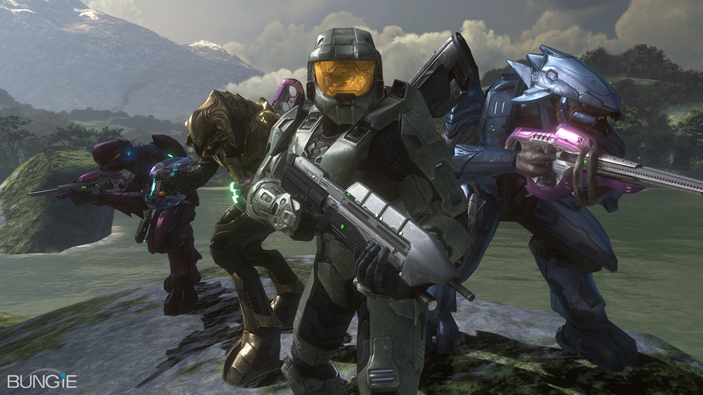
PLAYER 3 (Sangheili)
Name: N’tho ‘Sraom
Affiliation: Fleet of Retribution/Special Warfare Group/Special Operations
History: N’tho ‘Sraom is the youngest member of his Special Operations unit and is one of a growing number of human sympathizers amongst the Sangheili youth. He is a fairly typical young male adult Sangheili—he began compulsory military service at the end of adolescence, and remains unmarried with no close, non-familial relationships outside of his martial order. N’tho Sraom refused to stand idly by while the Prophets replaced Sangheili units with Jiralhanae packs, and now bears deep resentment toward those Sangheili politicians who landed his kind in their current predicament.
Although N’tho ‘Sraom’s romanticized nationalism is emblematic of all Sangheili, he has developed a healthy respect for humanity—not for their physical abilities or martial prowess, but for their audacity and resolve.
PLAYER 4 (Sangheili)
Name: Usze ‘Taham
Affiliation: Fleet of Retribution/Special Warfare Group/Fleet Security
History: Although Usze ‘Taham was born into a respected merchant family he was fathered by Toha ‘Sumai—one of the preeminent swordfighters of this age. Usze graduated with honors from the top War College in the Iruiru region of Yermo, Sanghelios (a distinction he shares with Rtas 'Vadum). Shortly after receiving his first post within the Covenant Navy he was offered a place on the Prophets’ Honor Guard but he declined citing “lack of practical experience”. In truth, he had no desire to be part of a largely ceremonial unit, and at the end of his third combat tour, Usze ‘Taham again refused the post—even though his superiors warned him such behavior could be misinterpreted as apostasy.
Since that time Usze has evaded countless punitive actions, at least two assassination attempts, and served with distinction for two additional tours before the Schism. Following the dissolution of the Covenant, he was approached by the Ascetics to become one of their liaisons within the Navy.
Descriptions des grades covenants dans les statistiques[modifier | modifier le wikicode]
- Heroes
- Brute Hero
- Brute Chieftain - Weapon (150) : Commanding troops requires both audacity and great strength.
- Brute Chieftain - Armor (150) : Giving quarter is not part of Jiralhanae military doctrine.
- Brute Hero
- Leaders
- Brute Leader
- Brute Captain (50) : Brute military doctrine states that to lead one must be seen.
- Brute Captain Major (50) : To be effective, officers need to inspire fear and respect.
- Brute Captain Ultra (50) : Advancement within the Jiralhanae armed forces is a bloody business.
- Brute Leader
- Specialists
- Brute Specialist
- Brute Stalker (30) : These Special Police Units are feared by all factions.
- Brute Jumpack (30) : There are few honors higher than serving in a Jump Pack Unit.
- Brute Bodyguard (30) : A Chieftain's personal guard also enforce tribal law.
- Grunt Specialist
- Grunt Heavy (10) : Trained as pilots and heavy weapons specialists; still jumpy.
- Grunt Spec-Ops (10) : Battle-hardened combat vets; the best of the Unggoy forces.
- Jackal Specialist
- Jackal Sniper (20) : Only battle-hardened veterans are chosen to become snipers.
- Flood Pure Form
- Pure Form Stalker (20) : The Pure Form is built within a framework of recast bone.
- Pure Form Ranged (30) : The Pure Form creates its missiles from battlefield detritus.
- Pure Form Tank (50) : The Pure Form is an engine of war crafted from living flesh.
- Hunter Specialist
- Hunter (150) : Hunters are deployed more as weapons platforms than troops.
- Brute Specialist
- Infantry
- Grunt Infantry
- Grunt Minor (10) : Under Brute leadership, recruits tend to be poorly equipped.
- Grunt Major (10) : More experience and gear doesn't always connote good morale.
- Jackal Infantry
- Jackal Minor (15) : Recruits are often posted as security or "movable shields".
- Flood Carrier Form
- Flood Carrier Form (10) : Those no longer able to fight are used as mobile incubators.
- Flood COmbat Form
- Combat Form - Human (10) : The Flood builds its army from the bodies of its enemies.
- Combat Form - Brute (10) : The Flood keeps its hosts alive so they last longer as fuel.
- Combat Form - Elite (10) : As a host is consumed, its knowledge is consumed as well.
- Sentinel Infantry
- Sentinel Aggressor Minor (5) : Sentinels are assembled as needed for repairs and defense.
- Brute Infantry
- Brute Minor (20) : Recruits compete for their postings as well as their gear.
- Brute Major (20) : Being promoted requires more than survival; one must kill.
- Brute Ultra (20) : There are two types of Brute veterans: tough and clever.
- Drone Infantry
- Drone Minor (10) : Yanme'e physiology is well suited for the role of infiltrator.
- Drone Major (10) : Drones aren't brave; they're just incapable of feeling fear.
- Grunt Infantry
- Giants
- Scarab
- Scarab - (Type-47 UHAP) (500) : Ultimate assault engine of the Covenant ground forces.
- Scarab
- Light
- Chopper
- Chopper - (Type-25 RAV) (100) : Primarily Brute-crewed reconnaissance and fast attack vehicle.
- Shade
- Shade - (Type-26 ASG) (50) : The name Shade is applied generically to all Covenant stationary anti-infantry guns.
- Ghost
- Ghost - (Type-32 RAV) (100) : Primary reconnaissance vehicle of the Covennt forces.
- Chopper
- Heavy
- Wraith
- Wraith - (Type-25) (200) : A Wraith is the backbone of any Covenant assault force.
- Wraith - (Type-52 AAA) (200) : Wraiths have become a common sight in the Inner Colonies.
- Phantom
- Phantom - (Type-52 TC) (250) : Heavily armed and armored troop transport VTOL craft.
- Wraith
- Standard
- Prowler
- Prowler - (Type-52 ISV) (150) : Primary armored scout car of the Covenant ground forces.
- Banshee
- Banshee (Type-26 GSA) (100) : Primary ground support aircraft of the Covenant forces.
- Prowler
Halo 3 : ODST (Field Guide)[modifier | modifier le wikicode]
Intel[modifier | modifier le wikicode]
Sadie's Story[modifier | modifier le wikicode]
- Voir : Journaux audio/Transcription
Superintendent[modifier | modifier le wikicode]

SUPERINTENDENT
Each of Earth's six tether cities is managed with the aid of an AI. The Superintendent is a 2nd Generation "dumb" AI tasked with making sure that the city of New Mombasa's infrastructure (read: the Departments of Health and Human Services, Housing, Public Safety, Recreation, Streets and Sanitation, and Utilities and Transportation) is running smoothly and safely.

New Mombasa[modifier | modifier le wikicode]
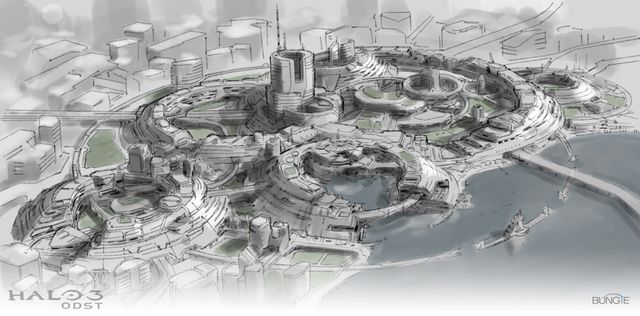
NEW MOMBASA
Two hundred and fifty years ago New Mombasa—at that time the world's busiest sea port—was chosen to be Earth's first tether city. Over the next eleven years the city experienced explosive growth, but nothing compared to what followed. The city grew out as well as up, its urban sprawl unequaled throughout the continent. By 2430 New Mombasa had absorbed all of the island and many of the surrounding towns found themselves overrun by residents of the old city. The switch was never official and many of the neighborhoods within direct line of sight to the Mombasa Tether still distribute newspapers and chatter directories under their "old" names, but all municipalities within a 74 km radius of the island are now referred to as Old Mombasa.
New Mombasa, 20 OCT 2552:
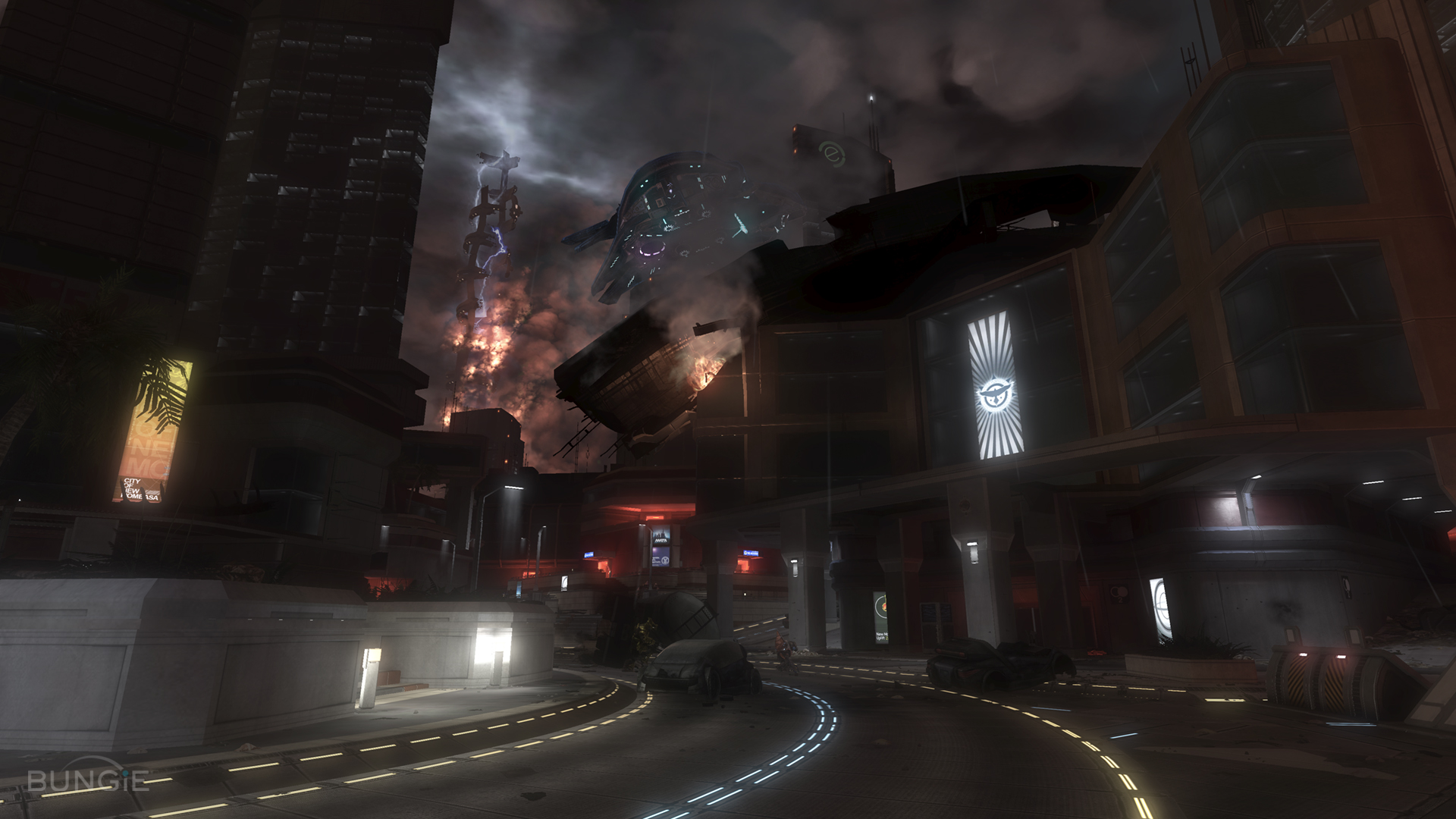
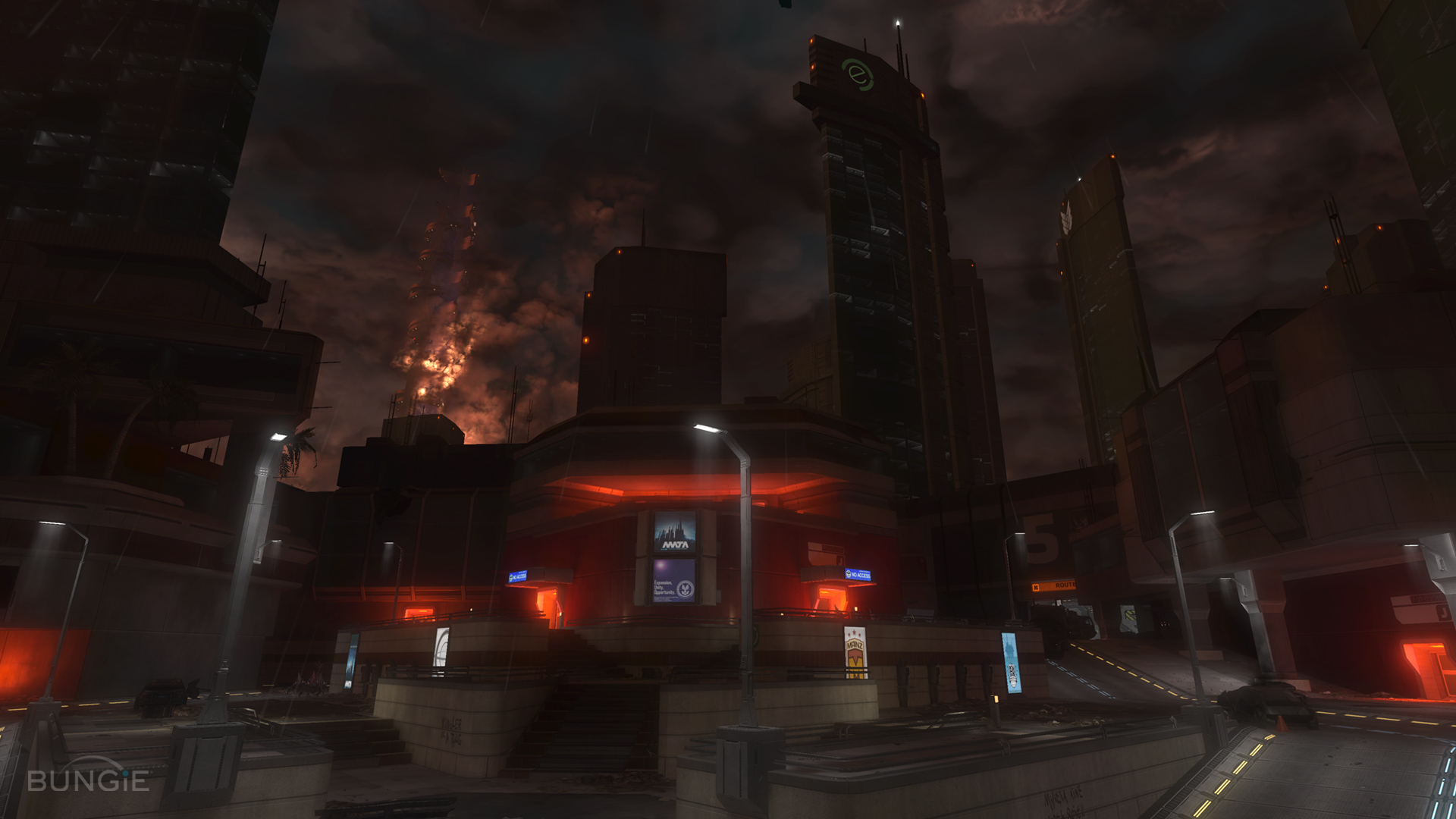
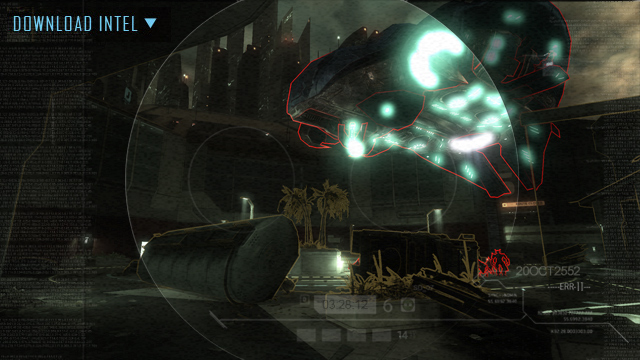
Health Pack[modifier | modifier le wikicode]
HEALTH PACK/OPTICAN
ATTENTION ALL UNSC PERSONNEL: Due to the ongoing evacuation efforts all health care personnel have been relocated to the Mombasa Quays area until which time they can be disembarked on outbound sea craft. In the unlikely event that you become separated from your unit or cannot contact a medic look for one of the many Optican™ MediGel™ First Aid stations around the city.
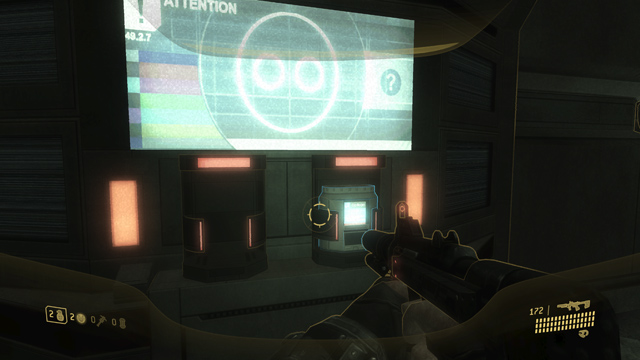
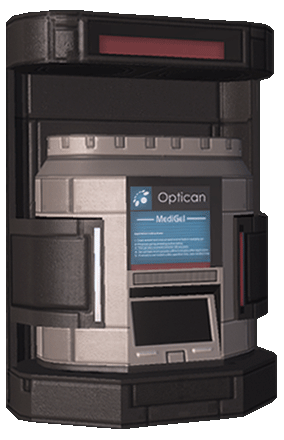
ODST[modifier | modifier le wikicode]
ORBITAL DROP SHOCK TROOPER
United Nations Space Command (UNSC) Orbital Drop Shock Troopers (ODST) are under the operational authority of Naval Special Weapons (NavSpecWeap). Their methods of operation allow them to conduct missions against targets that more conventional forces cannot approach undetected.
The ODSTs perform highly specialized, small scale, high-risk operations such as:
• Deep ground surveillance (DGS)
• Direct action (DA)
• Unconventional warfare
• Counter-terrorism operations
• Counter-contraband operations
• Personnel and special equipment recovery/capture
ODSTs are recruited from the Special Operations Groups of all the nations of the Unified Earth Government (UEG). Since the first group of “handpicked volunteers” was activated, ODSTs have been dropping “feet first” into combat.
Personnel[modifier | modifier le wikicode]
Buck[modifier | modifier le wikicode]

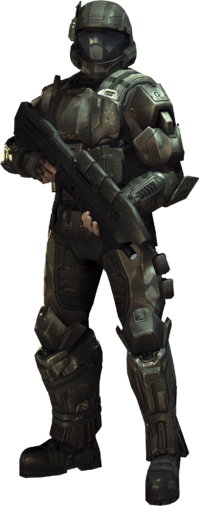
BUCK
Full name: BUCK, Edward
Blood type: O-
Height: 188cm
Weight: 89kg
Rating: Gunnery Sergeant (GySgt/E7)
Unit: [classified]
Service number: 92458-37017-EB
Enlistment date: 12/05/2528
Location: Karnak, Lombard, Draco III
Born: New Albany, Lombard, Draco III
Gender: M
Citizen: Draconian
Age: 42 –(b. 08/22/2510)
Occupation: Student
Eddie Buck is a career Marine that has seen more than his fair share of this war. He has had the dubious honor of participating in many of the wars’ most vicious battles; including both the liberation of Harvest and the fall of Reach. That he has survived through it all speaks volumes. Truly, if he was any better he’d be a Spartan.
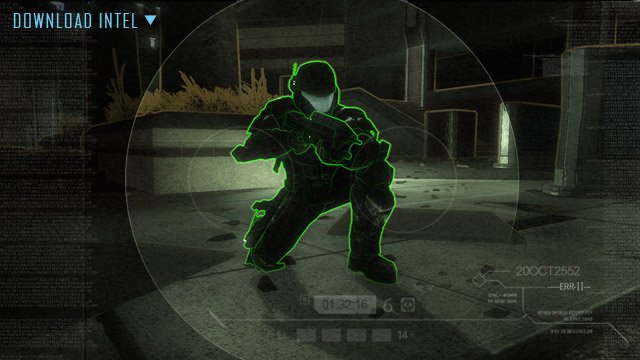
Dare[modifier | modifier le wikicode]

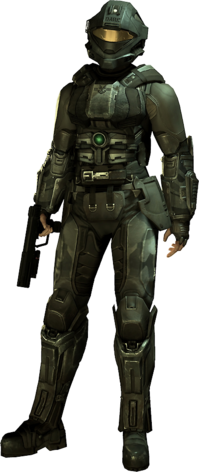
DARE
Full name: [classified]
Blood type: [classified]
Height: [classified]
Weight: [classified]
Rating: [classified]
Unit: [classified]
Service number: [classified]
Enlistment date: [classified]
Location: [classified]
Born: [classified]
Gender: F
Citizen: [classified]
Age: [classified]
Occupation: [classified]
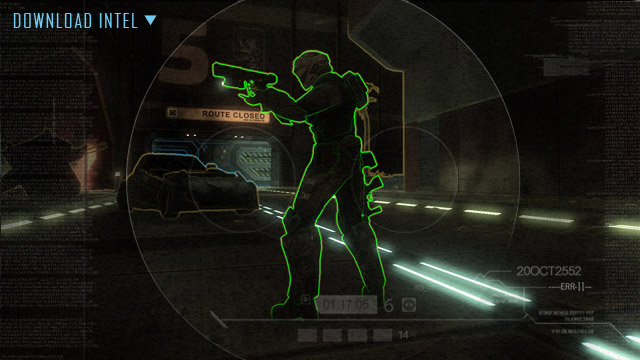
Dutch[modifier | modifier le wikicode]

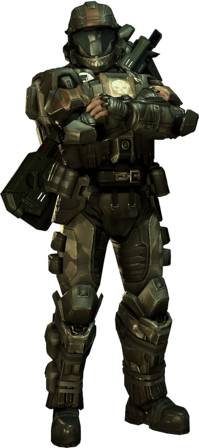
DUTCH
Full name: MILES, Taylor H.
Blood type: B+
Height: 190cm
Weight: 91kg
Rating: Corporal (Cpl/E4)
Unit: [classified]
Service number: 21175-12121-TM
Enlistment date: 09/09/2540
Location: Paris Island, New Paris, Mars
Born: Losantiville, Seven Hills, Mars
Gender: M
Citizen: Martian
Age: 33 –(b. 06/03/2519)
Occupation: Road train driver
Dutch’s former life as a road-train driver on Mars did well to prepare him for the arduous tasks of a heavy weapons specialist and driver in the ODSTs. Behind the death’s head rictus, jolly roger, and layer upon layer of black and gray armor is a man of deep spiritual convictions and respect for those he serves alongside.
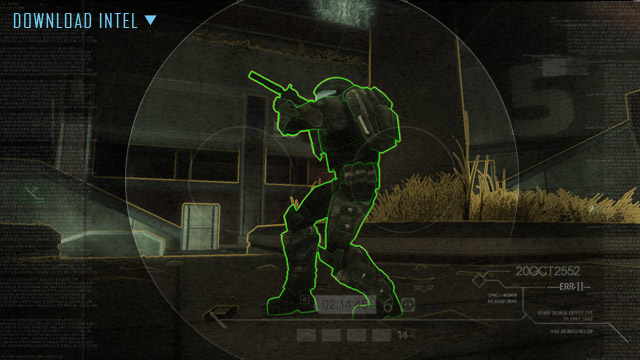
Romeo[modifier | modifier le wikicode]

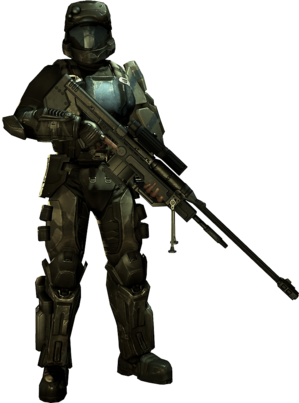
ROMEO
Full name: AGU, Kojo
Blood type: AB-
Height: 190cm
Weight: 91kg
Rating: Lance Corporal (LCpl/E3)
Unit: [classified]
Service number: 14606-85099-KA
Enlistment date: 03/12/2541 (MM)
Location: Holetown, New Barbados, Emerald Cove
Born: Castra arcology, Castra, Madrigal
Gender: M
Citizen: Madrigali
Age: 28 –(b. 06/12/2524)
Occupation: Merchant Marine
Romeo sees his true vocation as a ladies’ man. But just because he’s a lover doesn’t mean he can’t be a fighter—and a damned fine one at that. He keeps his gear clean, his suit looking sharp, and his body lean and strong. He may not be a shining example of the UNSC off the battlefield, but on it he is a consummate combatant.
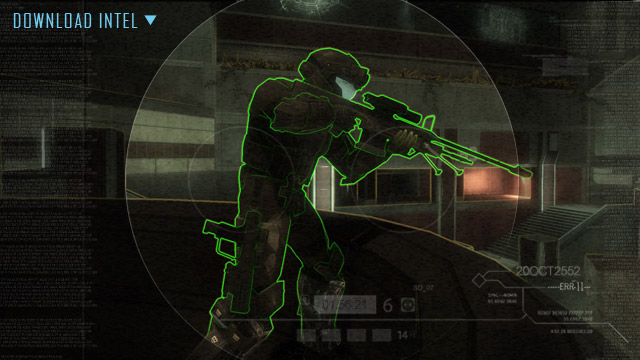
Mickey[modifier | modifier le wikicode]

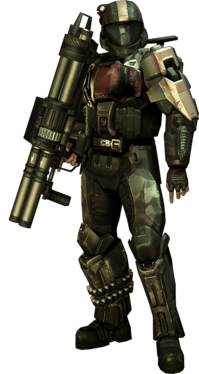
Mickey
Full name: CRESPO, Michael
Blood type: A-
Height: 184cm
Weight: 85kg
Rating: Private First Class (PFC/E2)
Unit: [classified]
Service number: 51033-15973-MC
Enlistment date: 06/04/2548
Location: Crisium City, Naniwa, Luna
Born: Crisium City, Naniwa, Luna
Gender: M
Citizen: Lunar
Age: 22 –(b. 10/20/2530)
Occupation: Student
Mickey LOVES being an ODST. More than he did being a pilot. More than he did being a crew chief on a Pelican gunship. He is no stranger to battle and has a fair number of notches in his belt, but he is unique amongst his ODST brothers in that he has never seen absolute ruination visited upon a human colony-world by the Covenant.
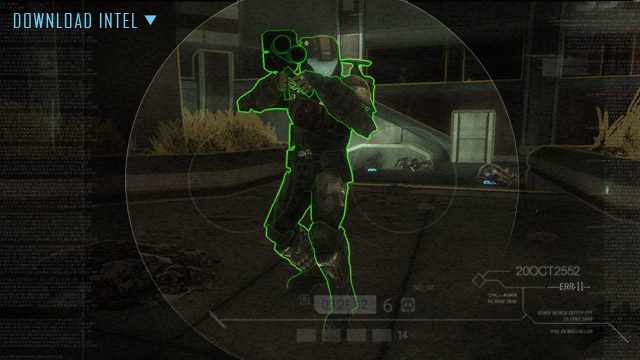
Rookie[modifier | modifier le wikicode]

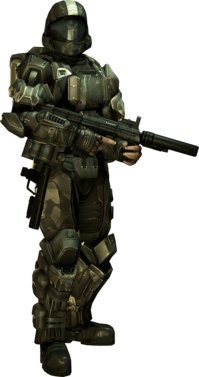
The ROOKIE
Full name: [classified]
Blood type: O+
Height: 186cm
Weight: 88kg
Rating: Lance Corporal (LCpl/E3)
Unit: [classified]
Service number: 11282-31220-JD
Enlistment date: 07/07/2547
Location: Crisium City, Naniwa, Luna
Born: Crisium City, Naniwa, Luna
Gender: M
Citizen: Lunar
Age: [classified]
Occupation: Student
This Marine was recently transferred from the 26th MEF, part of a Rapid Offensive Picket that suffered near-annihilation at New Jerusalem, Cygnus. Like most ODSTs, his actions speak louder than words.
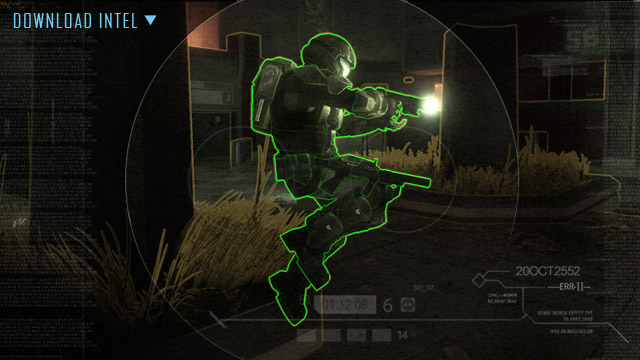
Ordnance[modifier | modifier le wikicode]
Auto Mag[modifier | modifier le wikicode]
M6C/SOCOM

M6C/SOCOM
The M6 Personal Defense Weapon System is the standard sidearm family of the UNSC. The M6 family is designed primarily for ruggedness and reliability. Certain models have been ‘up-sized’ to be used by Spartan’s in Mjolnir armor. Even though the 'Spartan" issue pistols are larger than the standard-issue variants (~117%) they can still share magazines.
The M6 series are recoil-operated and magazine-fed. It fires 12.7mm x 30 semi-armor-piercing high-explosive ammunition (standard issue). M6 series handguns are issued in three different finishes: hard chrome, black polymer, and electroless nickel.
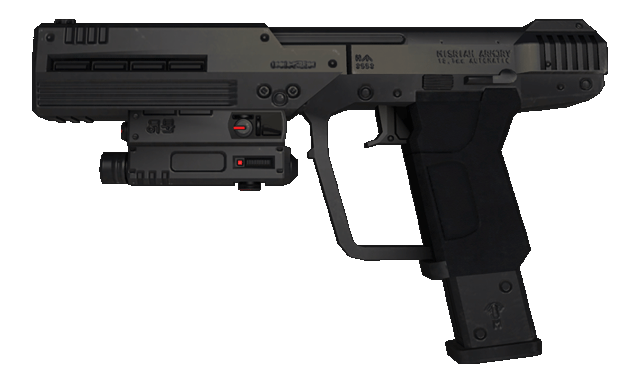
The M6C/SOCOM variant has an integrated sound suppressor.
Official Designation: M6 PDWS (Personal Defense Weapon System)
Common Slang Terms: Go-mag, cannon, hand cannon, power drill, HE pistol, heavy pistol
Cartridge: 12.7mm x 40 SAP-HE (semi-armor-piercing, high-explosive)
Max. effective range: 50m
Mag. capacity: 8 rounds (6, 12 in some models)
Rate of fire: DAO
Unit cost: 1615 cR.
Dimensions:
• Length o/a: 22.86 cm (9 in.) standard
• 26.7 cm (10.5 in.) 'up-sized'
• Weight (loaded/12 rnds): 1.8 kg (4.09 lbs) standard
• 2.7 kg (5.95 lbs) 'up-sized'
Variants:
• M6A: standard issue/black polymer finish
• M6B: 'Officer's model'—issued with smart-linked scope [KFA-2]/hard chrome finish
• M6C: 'up-sized', standard issue/black polymer finish
• M6C/SOCOM: accurized—issued with smart-linked scope [VnSLS/V 6E]/black polymer finish
• M6D: 'up-sized', 'Officer's model'—issued with smart-linked scope [KFA-2]/hard chrome finish
• M6E: standard issue/electroless nickel finish
• M6F: 'Officer's model'—issued with smart-linked scope [KFA-2]/electroless nickel finish
• M6G: 'up-sized', standard issue/electroless nickel finish
• M6H: 'up-sized', 'Officer's model'—issued with smart-linked scope [KFA-2]/electroless nickel finish
• M6I: select-fire variant; detachable shoulder-stock/black polymer finish
• M6J/C: carbine variant; 355mm barrel, detachable shoulder-stock/electroless nickel finish
• M6K: police 'undercover' variant; 6 rnd magazine capacity/black polymer finish
SMG[modifier | modifier le wikicode]
M7S SUBMACHINE GUN

M7 SUBMACHINE GUN
The M7 submachine gun is gas-operated and magazine-fed. It fires 5mm x 23 caseless ammunition. Recoil from all but sustained fire is very controllable. Although the M7 submachine-gun is primarily issued to vehicle crews, it is also a favorite of commando teams in its sound suppressed version – the M7S.
Sustained automatic fire tends to cause the muzzle to “walk” upwards as recoil compounds. Submachine guns, while not accurate over long distances, are particularly effective in close quarters.
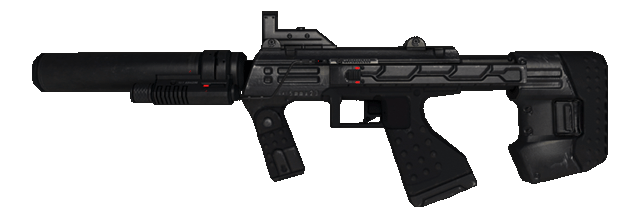
Official Designation: M7/Caseless Submachine Gun
Common Slang Terms: bullet hose, black box, chum, popcorn
Cartridge: 5mm x 23 caseless
Max. effective range: 50m
Mag. capacity: 60
Rate of fire: 900 rnds/min
Unit Cost: 1484 cR.
Dimensions:
• Length, stock extended: 627mm (24.68 in.)
• Length, stock retracted: 474mm (18.66 in.)
• Weight (loaded): 1.3 kg (2.86 lbs)
Variants:
• M7: standard issue
• M7S: issued with sound suppressor [SS/M 49] and smart-linked scope [SLS/V 5B]
Brute Plasma Rifle[modifier | modifier le wikicode]
BRUTE PLASMA RIFLE

BRUTE PLASMA RIFLE
Type-25 Directed Energy Rifle
Official designation: Type-25 DER
Length o/a: 66 cm (26 in.)
Weight: 5.9 kg (13 lbs)
Cartridge: unknown
Max. effective range: 50 meters (155 ft)
Muzzle velocity: 126 m/s (413 f/s)
Battery capacity: 400 shots
Rate of fire: 360~540 shots/min
Unit Replacement cost: N/A
Description: The Type-25 DER is a battery-powered directed energy weapon capable of fully automatic fire. The exact mechanism by which it functions is currently under investigation.
Observations: Up until just recently the Plasma Rifle had been the primary weapon of the Covenant’s officer core. The weapon has a power output of 100~150 Kv@2~3 dA.
It has been widely noted that the disparity in the effective combat range between Covenant short and long arms are much greater than those of the UNSC—this is also reflected in the Covenant’s combat doctrine: destroy enemy morale with harassing fire from distant or hidden snipers and intimate exposure to the alien-ness of their infantry.
In addition to the standard issue "blue-purple" DER there is also a "red" variant that has a much higher rate of fire, and thus a greater likelihood of overheating. So far this variant has only been found in the hands of the brutes, and even then, only since they have seen a return as front-line combatants.
VISR Mode[modifier | modifier le wikicode]
VISR
VISR [Visual Intelligence System, Reconnaissance]
Many technologies initially developed for the MJOLNIR project have gained widespread adoption; the use of ceramic-titanium composites for body armor and helmet-integrated neural interfaces being the most visible. The ODST helmet is issued with the VISR proprietary data management suite. VISR enables a user to link into UEG, CAA, and UNSC infrastructure systems at the local, national, and global levels (actual access level is administered on a need/rating basis). This allows the user to store and review audio files (up to 610MB combined), street level navigational data, and receive secure real-time mission data. In addition, every current issue helmet is equipped with low-light vision enhancement [ODST BIOS A29.817941B.01 or later].
Dimensions:
• Sizes available: 6.5 — 8 (.125 increments)
• Sound attenuation: 21 db @ 1,000Hz, 37 db @ 4,000 Hz
• Impact deceleration: V—190g @ 17 fps; H—190g @ 20 fps
• Penetration protection: 1.8 kg @ 1.5 m (4 lbs @ 5 ft)
• Weight (average): 1.9 kg (4.2 lbs)
Unit cost: 1926 cR.
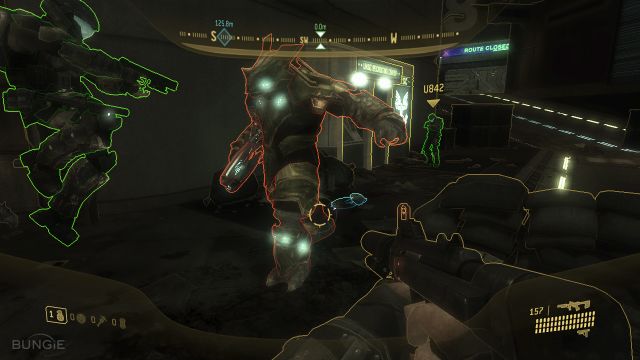
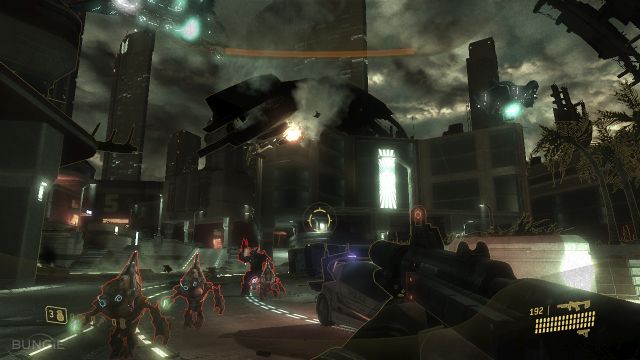
Drop Pod[modifier | modifier le wikicode]
SOEIV 'DROP POD'
SINGLE OCCUPANT EXOATMOSPHERIC INSERTION VEHICLE
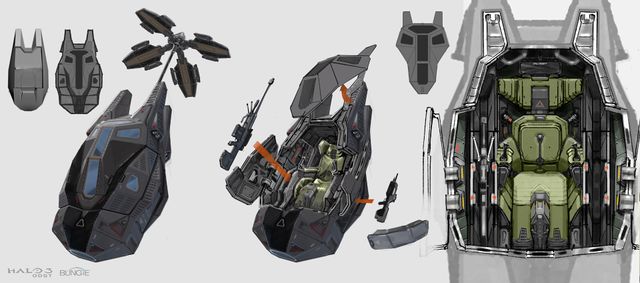
The SOEIV is an angular pod, approximately eighteen (18) feet tall, eight and a half (8.5) feet wide, and nine (9) feet deep with an entry hatch on one side. Within it is a crash seat, communications gear, numerous equipment racks, and a rudimentary control system. In spite of the size of the pod, there is not much room to move around, as the space given over to equipment storage lines the interior attached to the frame.
The trooper enters the SOEIV and straps in facing the hatch. The hardened and shielded communications gear, which is built directly into the hatch, feeds the soldier information relevant to the current operation as well as providing a link between all members of the unit during the drop. While within the SOEIV a soldier's helmet integrated comm units are redundant and are normally only used if the pod's comm gear malfunctions.
A 30-second countdown begins on the commander’s mark, and the SOEIVs fire quickly down through the ship’s belly. The SOEIV is balanced to stabilize in a feet-down position. The pod has limited maneuvering capability, used primarily to coordinate landings, but may be used to avoid defensive anti-aircraft fire. However, if defensive anti-aircraft is present it is almost a mathematical certainty that some pods will be lost. If the armored skin that covers a pod is damaged before or during its entry into atmosphere it has a tendency to fail spectacularly. And this is the reason for the SOEIV's small size—each hit only results in one death rather than the deaths of the entire unit.
UNSC insertion protocols call for the CO’s SOEIV to accelerate after launch, placing it in the front rank of the advance. The reasons for this rule include the strongly held belief that officers should lead rather than follow, should be willing to do anything their troops are asked to do, and should expose themselves to the same level of danger as their subordinates.
The most compelling reason, however, is the need to collect, sort, and organize the troops the moment their boots touch ground. Experience demonstrates that whatever the ODSTs manage to accomplish during the first so-called “golden hour” on the ground will have a disproportionate effect on the success or failure of the entire mission. The commander’s pod is equipped with a lot of gear that the regular “eggs” are not, including high-powered imaging gear, tactical sensors, and a 4th generation "dumb" AI.
After the SOEIV has penetrated the atmosphere, the upper exterior panels separate acting as a drag-type chute, slowing its descent some. At about 50 meters, the pod’s computer controlled breaking rockets engage, slowing the pod further; allowing for a safe though somewhat abrupt landing.
Drag chutes on SOEIVs do fail on rare occasions, leaving the pod’s occupant to die on impact. It’s the death that every ODST trooper fears, and is referred to in hushed tones as “digging your own grave."
Upon landing, each ODST is responsible for stripping their pod of its store of extra weapons, ammo, and other supplies, which are then hauled to the unit’s temporary base camp. ODSTs are used to operating without resupply for extended periods, and they are well known to be at their best when under difficult conditions.
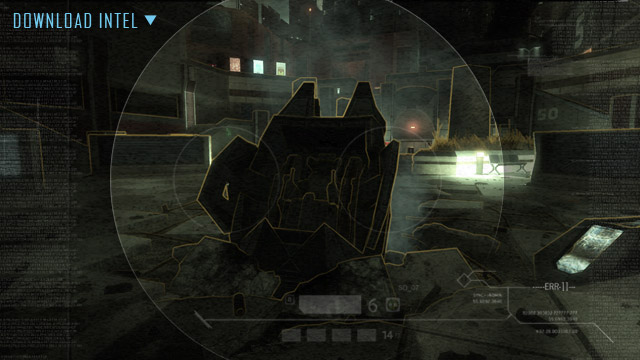
Crew: 1
Length: 2.74 meters (9 feet)
Span: 2.6 meters (8.5 feet)
Height: 5.5 meters (18 feet)
Weight (empty): 870 kg (1918 lbs)
Enemies[modifier | modifier le wikicode]
Grunt[modifier | modifier le wikicode]

GRUNT (Unggoy)
Short and broad bipedal arthropods. Known to speak several human languages. Have a distinct vomit/manure smell about them.
Typically travel in groups up to eight. Lack discipline; tend to panic once local command has been eliminated. This will occasionally manifest itself as a suicidal attempt to eliminate the forces that eliminated its commander(s).
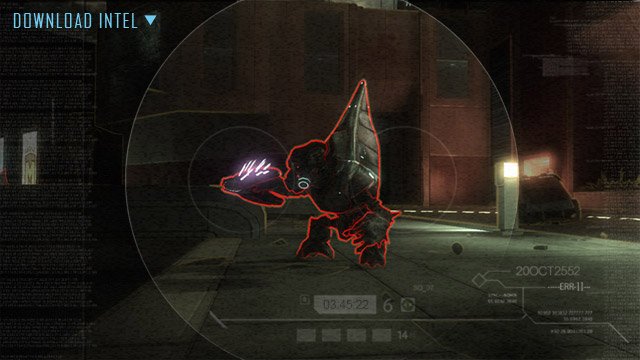
Jackal[modifier | modifier le wikicode]

JACKAL (Kig-yar)
Tall and lanky saurians. Most of their vocalizations may be described as barking or a ratchet-like grunting. There is a salty, occasionally acrid, smell associated with them.
They are typically found in small (one or two individuals) sniper/scout detachments or marksman half-squads (one marksman and three short range security). What they lack in overall discipline they make up for with bloodthirstiness.
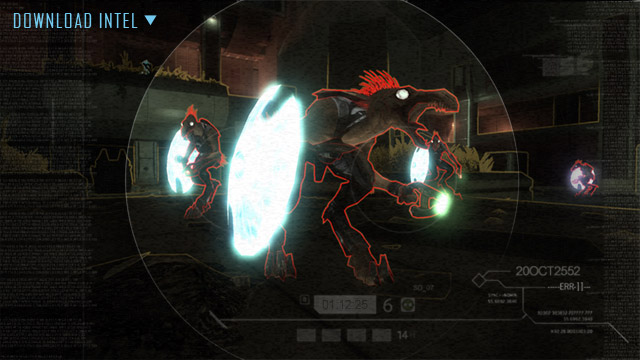
Drone[modifier | modifier le wikicode]

DRONE (Yanme'e)
Tall, flying multi-limbed arthropods. Rapid clicking vocalizations. Have a slight musty odor associated with them.
They always travel in groups of four or more, are well disciplined, and extremely aggressive. Drones are best described as irregular troops—their high morale and fierceness may be biochemical in nature.
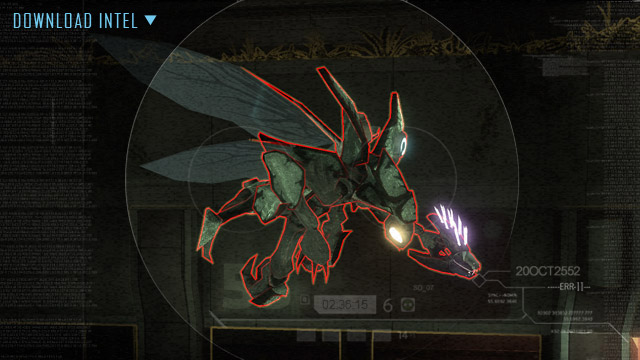
Brute[modifier | modifier le wikicode]

BRUTE (Jiralhanae)
Massive and ape-like. Many have been observed speaking human languages. Depending on location and MOS they will be encountered in groups up to eight.
They are fearless, vicious opponents and must not be underestimated. Currently, they fill the command role that Elites occupied previously. Whether or not this is indicative of a power shift within the Covenant is of no consequence to the current operation. ANYTHING that seeks to obstruct the successful completion of your mission is a legitimate target.
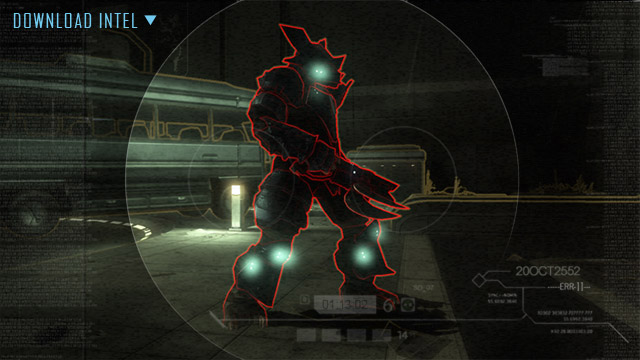
Hunter[modifier | modifier le wikicode]

HUNTER (Lekgolo)
Gigantic, heavily armored bipeds. They don't speak often, but when they do it will sound like a thunderous, subsonic rumbling. They travel in pairs and exhibit excellent discipline, unwavering morale, and steady focus.
Hunters should be thought of more as mechanized weapon platforms rather than single enemy combatants. Avoid engagement whenever possible.
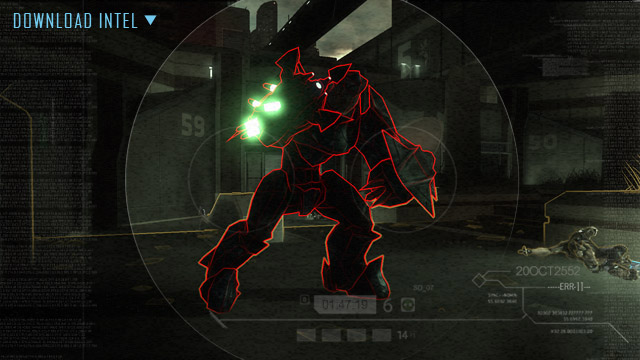
Halo : Reach[modifier | modifier le wikicode]
CAA Factbook[modifier | modifier le wikicode]
- Voir : CAA Factbook
Personnel[modifier | modifier le wikicode]
Ordnance[modifier | modifier le wikicode]
Magnum[modifier | modifier le wikicode]
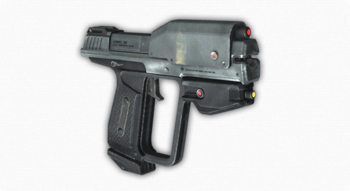
NAME: MAGNUM
AFFILIATION: UNSC
Magnum:
The M6G (more formally Personal Defense Weapon System, Caliber 12.7mm, M6) is a semi-automatic, recoil-operated, magazine-fed handgun. It is the standard sidearm of all UNSC personnel and is highly regarded for its ruggedness and reliability. Several variants are issued with the smart-linked KFA-2 x2 scope.
Assault Rifle[modifier | modifier le wikicode]
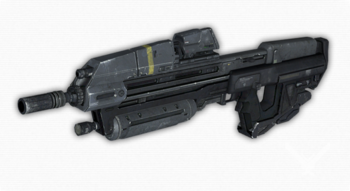
NAME: ASSAULT RIFLE
AFFILIATION: UNSC
MA37:
The MA37 (more formally Individual Combat Weapon System, Caliber 7.62 mm, MA37) is an air-cooled, gas-operated rifle firing 7.62x51mm ammunition. It is magazine-fed and is capable of fully automatic fire. The MA37 (MA5 for Marines and Navy) first entered service with the UNSC in 2437, it has remained the primary service rifle of all branches of the UNSC ever since.
DMR[modifier | modifier le wikicode]
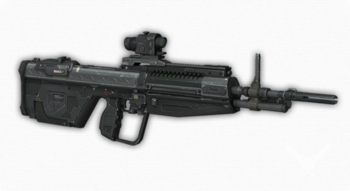
NAME: DESIGNATED MARKSMAN RIFLE
AFFILIATION: UNSC
DMR:
The DMR (more formally the Designated Marksman Rifle, Caliber 7.62 mm, M392) is an air-cooled, gas-operated rifle firing 7.62x51mm ammunition.
Although it saw more widespread use throughout all branches of the UNSC prior to 2548, it has since been superseded in use by the BR55 in all branches but the Army.
Shotgun[modifier | modifier le wikicode]
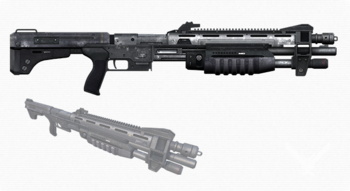
NAME: SHOTGUN
AFFILIATION: UNSC
Shotgun:
The M45 TS (more formally Tactical Shotgun, 8 Gauge, Pump Action, M45) is a pump-action, magazine-fed (dual tubular, non-detachable type) shotgun firing 8 gauge magnum (3.75”) ammunition.
Sniper Rifle[modifier | modifier le wikicode]
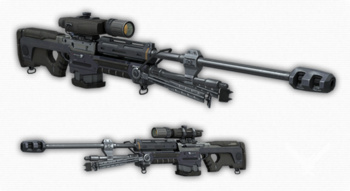
NAME: SNIPER RIFLE
AFFILIATION: UNSC
SRS99:
The SRS99 (more formally Special Applications Rifle, Caliber 14.5 mm, SRS99) is a gas-operated rifle firing 14.5x114mm ammunition. The SRS first entered service with the Army in 2460, because of its modularity and ongoing manufacturer support the SRS99 was adopted by all branches in 2521.
Grenade Launcher[modifier | modifier le wikicode]
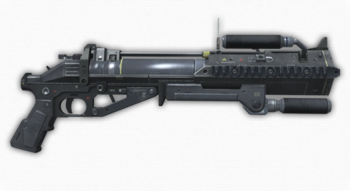
NAME: GRENADE LAUNCHER
AFFILIATION: UNSC
Grenade Launcher:
The M319 IGL (more formally Individual Grenade Launcher, Caliber 40mm, M319) is a single shot, break-action, grenade launcher firing 40mm ammunition. Because of its simplicity, ruggedness, and firepower, the M319 has been a mainstay within the UNSC Army’s arsenal since its official adoption in 2263.
Rocket Launcher[modifier | modifier le wikicode]
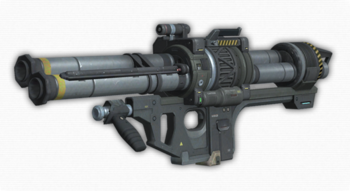
NAME: ROCKET LAUNCHER
AFFILIATION: UNSC
Rocket Launcher:
The M41SSR MAV/AW (more formally Medium Anti-Vehicle / Assault Weapon, Bore 102mm, M41 Surface-to-Surface Rocket launcher) is a man-portable, shoulder-fired, two-tube, 102mm rocket launcher. It has two main components: the magazine (the disposable part of the system) and the launcher.
Spartan Laser[modifier | modifier le wikicode]
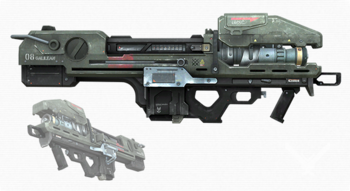
NAME: SPARTAN LASER
AFFILIATION: UNSC
Spartan Laser:
The M6 G/GNR (more formally Weapon/Anti-Vehicle, Directed Energy, M6) is a semi-automatic only laser weapon. It can be used in both anti-vehicle and anti-personnel roles. The weapon has an integrated Wyrd III optics suite (smart-linked).
Machine Gun[modifier | modifier le wikicode]
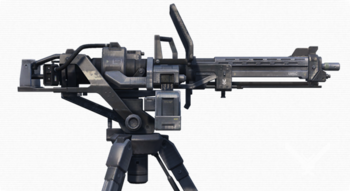
NAME: MACHINE GUN
AFFILIATION: UNSC
Machine Gun:
The M247H HMG (more formally Machine Gun, Caliber 7.62 mm, M247) is an air-cooled, gas-operated, electrically fired, linkless fed weapon. It can be used in both anti-personnel and anti-vehicle roles.
Plasma Pistol[modifier | modifier le wikicode]
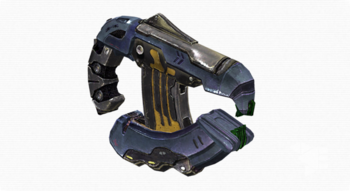
NAME: PLASMA PISTOL
AFFILIATION: COVENANT
Type-25 Pistol:
The Type 25 Pistol (or T25 DEP) is more commonly identified as the Plasma Pistol. This small directed energy weapon has two modes of fire: semi-automatic direct and semi-guided AOE. The secondary AOE mode drastically reduces battery life.
Needler[modifier | modifier le wikicode]
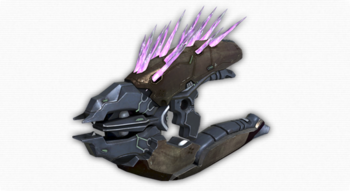
NAME: NEEDLER
AFFILIATION: COVENANT
Needler:
The Type-33 Guided Munitions Launcher (or T33 GML) is more commonly identified as the Needler. It fires unconventional projectiles that are very long and very sharp—hence Needler. The projectiles are guided by some unknown mechanism and detonate several seconds after coming to rest in soft tissue.
Spike Rifle[modifier | modifier le wikicode]
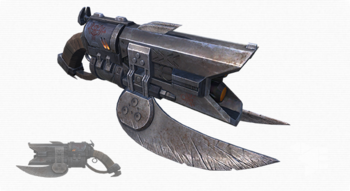
NAME: SPIKE RIFLE
AFFILIATION: COVENANT
Spike Rifle:
The Type-25 Carbine (or T25 C) is more commonly identified as the spiker. This weapon was encountered 25 years ago, and has remained the primary weapon of their shock troops since that time.
Plasma Rifle[modifier | modifier le wikicode]
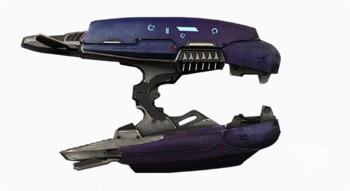
NAME: PLASMA RIFLE
AFFILIATION: COVENANT
Plasma Rifle:
The Type-25 Directed Energy Rifle (or T25 DER) is more commonly identified as the plasma rifle. This weapon was one of the earliest and most frequently encountered. It occupies a role very similar to the MA5/MA37.
Plasma Repeater[modifier | modifier le wikicode]
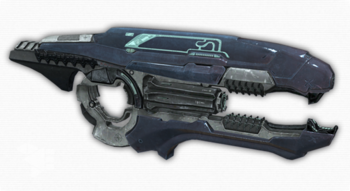
NAME: PLASMA REPEATER
AFFILIATION: COVENANT
Plasma Repeater:
The Type-51 Directed Energy Rifle/Improved (or T51 DER/I) is more commonly identified as the Plasma Repeater. This weapon has only been encountered very recently and only in very limited numbers. It is very likely it is either new to the Covenant arsenal or it is a branch specific weapon.
Needle Rifle[modifier | modifier le wikicode]
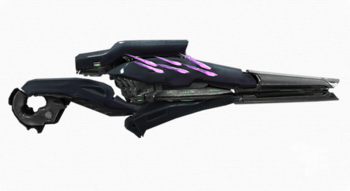
NAME: NEEDLE RIFLE
AFFILIATION: COVENANT
Type-31 Rifle:
The Type-31 Rifle (or T31 rifle) is more commonly identified as the Needle Rifle. It fires unconventional projectiles that are very long and very sharp—hence Needle rifle. The projectiles detonate several seconds after coming to rest in soft tissue.
Focus Rifle[modifier | modifier le wikicode]
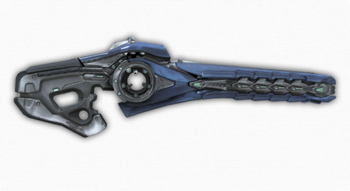
NAME: FOCUS RIFLE
AFFILIATION: COVENANT
Focus Rifle:
The Type-52 Special Applications Rifle (or T52 SAR) is also identified as the Focus Rifle. This directed-energy weapon is believed to be battery-powered. The exact mechanism by which it functions is currently under investigation.
Concussion Rifle[modifier | modifier le wikicode]
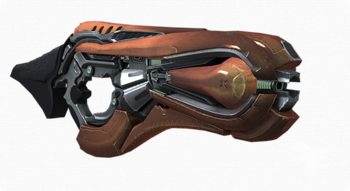
NAME: CONCUSSION RIFLE
AFFILIATION: COVENANT
Concussion Rifle:
The Type-50 Directed Energy Rifle/Heavy (or T50 DER/H) is more commonly identified as the Concussion Rifle. Because of this weapon’s relative rarity, it is theorized that its use is restricted either by branch or unit.
Fuel Rod Gun[modifier | modifier le wikicode]
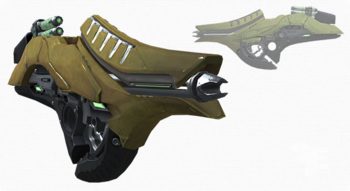
NAME: FUEL ROD GUN
AFFILIATION: COVENANT
Fuel Rod Gun:
The Type-33 Light Anti-Armor Weapon (or T33 LAAW) is more commonly identified as the fuel rod gun. It is a shoulder-launched, man-portable support weapon employed in both anti-personnel and anti-vehicle roles.
Plasma Launcher[modifier | modifier le wikicode]
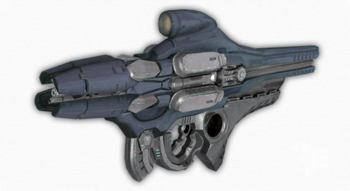
NAME: PLASMA LAUNCHER
AFFILIATION: COVENANT
Plasma Launcher:
The Type-52 Guided Munitions Launcher/Explosive (or T52 GML/E) is more commonly identified as the Plasma Launcher. This system is capable of launching and guiding up to four super-heated plasma bolts at a single target. The bolts will continue to track even if the operator is killed.
Plasma Turret[modifier | modifier le wikicode]
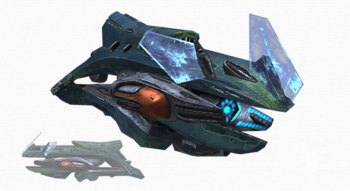
NAME: PLASMA TURRET
AFFILIATION: COVENANT
Plasma Turret:
The Type-52 Directed Energy Support Weapon (or T52 DESW) is more commonly identified as the plasma cannon. This weapon has only been encountered very recently and very likely represents a universal replacement for the aging T42.
Energy Sword[modifier | modifier le wikicode]
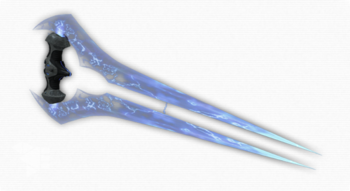
NAME: ENERGY SWORD
AFFILIATION: COVENANT
Energy Sword:
The Type-1 Energy Weapon/Sword (or T1 EW/S) is more commonly identified as the Energy Sword. This weapon consists of a grip that contains an energy storage/generation device and the blade projector and, when activated a blade composed of plasma stabilized within an energy field. The exact mechanism by which it functions is currently under investigation.
Gravity Hammer[modifier | modifier le wikicode]
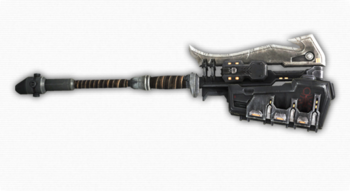
NAME: GRAVITY HAMMER
AFFILIATION: COVENANT
Gravity Hammer
The Type-2 Energy Weapon/Hammer (or T2 EW/H) is more commonly identified as the Gravity Hammer. This weapon consists of a haft, head, and blade. A field generator, which is located in the head, emits a kinetic pulse (~4.5 meters). The exact mechanism by which it functions is currently under investigation.
Fragmentation Grenade / Plasma Grenade[modifier | modifier le wikicode]
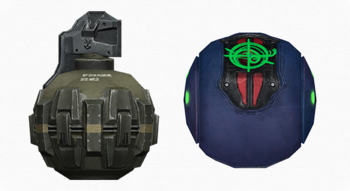
NAME: M9 HE/DP / T1 APG
AFFILIATION: UNSC / COVENANT
Fragmentation Grenade (UNSC):
The M9 High Explosive/Dual Purpose is the ubiquitous hand grenade used by all branches of the UNSC armed forces.
Plasma Grenade (Covenant):
The Type-1 Anti-Personnel Grenade (or T1 APG) is more commonly identified as the plasma grenade. Its ability to distinguish between targets is still under investigation.
Mongoose[modifier | modifier le wikicode]
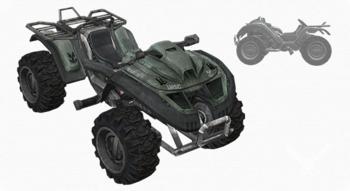
NAME: MONGOOSE
AFFILIATION: UNSC
Mongoose:
The M274 Ultra-Light All-Terrain Vehicle, more widely known as the mongoose, is an unarmored vehicle used primarily by couriers within the UNSC.
Warthog[modifier | modifier le wikicode]
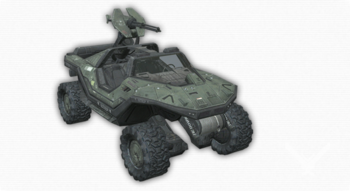
NAME: WARTHOG
AFFILIATION: UNSC
Warthog: 100km/h (62mph)
The M12 Force Application Vehicle, more widely known as the Warthog, is a highly mobile, all-wheel-drive, all-wheel-steering, ICE-powered vehicle equipped with a manual transmission. The M12 can be configured to become a troop carrier, armament carrier, ambulance, reconnaissance vehicle, or communications vehicle. All M12-based vehicles are designed to travel both on and off-road, in all weather conditions.
Scorpion[modifier | modifier le wikicode]
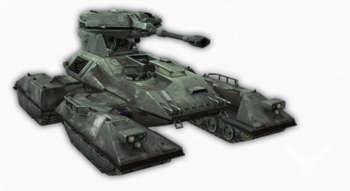
NAME: SCORPION
AFFILIATION: UNSC
Scorpion:
The M808 Main Battle Tank (MBT), more widely known as the Scorpion, is the primary armored fighting vehicle of the UNSC ground forces. The Scorpion is large and heavily armored, but is surprisingly nimble. The four-track design (each track mounted on an independent, computer-controlled suspension system) allows the Scorpion to climb over or maneuver around large debris or other battlefield obstacles.
Falcon[modifier | modifier le wikicode]
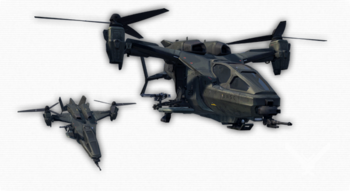
NAME: FALCON
AFFILIATION: UNSC
UH-144 FALCON:
The UH-144 is a versatile, transverse-rotor multipurpose utility helicopter. Two Falcons can transport a fully-equipped infantry squad faster than any previous system, and provide overwhelming support fire, in most weather conditions.
Ghost[modifier | modifier le wikicode]
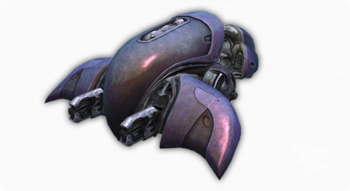
NAME: GHOST
AFFILIATION: COVENANT
Ghost:
The Type-32 Rapid Attack Vehicle (T32 RAV), more commonly identified as the Ghost, is a one-man gravity-effect vehicle, primarily used in a reconnaissance and close infantry support role. It is essentially a “hover sled”—it hovers low to the ground and moves very quickly. The vehicle is armed with two (2) linked forward-firing plasma cannons.
Revenant[modifier | modifier le wikicode]
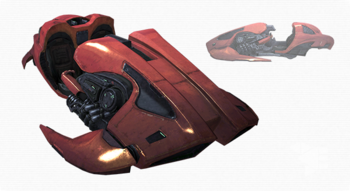
NAME: REVENANT
AFFILIATION: COVENANT
Revenant:
The Type-48 Light Assault Gun Carriage (T-48 LAGC), more commonly identified as the Revenant. While this vehicle is highly maneuverable, it is open and lightly armored—providing very little protection to its crew.
Wraith[modifier | modifier le wikicode]
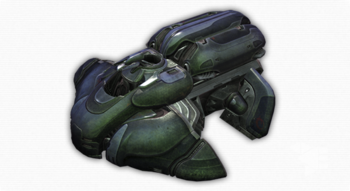
NAME: WRAITH
AFFILIATION: COVENANT
Wraith:
The Type-26 Assault Gun Carriage (T26 AGC), more commonly identified as the Wraith, is the primary armored fighting vehicle used by the Covenant. It is bulbous and thickly armored, but surprisingly maneuverable.
Banshee[modifier | modifier le wikicode]
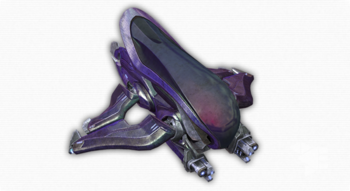
NAME: BANSHEE
AFFILIATION: COVENANT
Banshee:
The Type-26 Ground Support Aircraft (T26 GSA), more commonly identified as the Banshee, is typically used for reconnaissance, ground support, and ground attack missions. It is lightly armored and, while not particularly vulnerable to small arms, can be brought down by concentrated fire from infantry.
Spirit[modifier | modifier le wikicode]
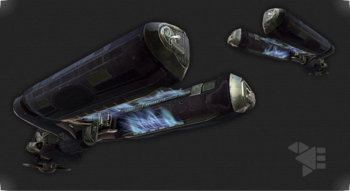
NAME: SPIRIT
AFFILIATION: COVENANT
TYPE-25 SPIRIT:
The Type-25 Troop Carrier (or T25 TC) is also known as the Spirit, although it is almost universally identified as troop carrier or dropship. It is capable of carrying up to 30 infantry and 2 vehicles. It is armed with one heavy plasma auto-cannon.
Enemies[modifier | modifier le wikicode]
Grunt[modifier | modifier le wikicode]
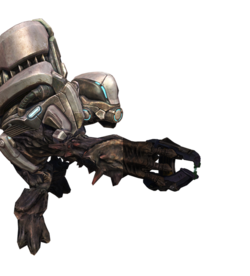
GRUNT
Covenant
FULL NAME: UNGGOY
AFFILIATION: COVENANT
Short and broad bipedal arthropods. Typically travel in groups up to eight. Lack discipline; tend to panic once local command has been eliminated. This will occasionally manifest itself as a suicidal attempt to eliminate the forces that eliminated its commander(s).
Jackal[modifier | modifier le wikicode]
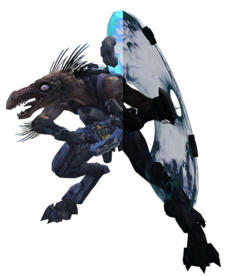
JACKAL
Covenant
FULL NAME: KIG-YAR
AFFILIATION: COVENANT
Jackals and Skirmishers are of the same species, with the smaller, more lightly built specimens seeing deployment as dedicated ranger or sniper units (Jackals) and the larger, more heavily muscled specimens comprising grenadier-type units (Skirmishers).
Skirmisher[modifier | modifier le wikicode]
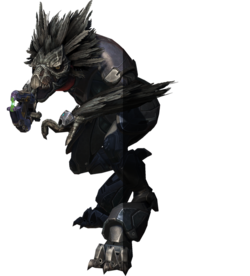
SKIRMISHER
Covenant
FULL NAME: KIG-YAR
AFFILIATION: COVENANT
Skirmisher:
The Jackal and Skirmisher are of the same species, with the larger, more heavily muscled specimens comprising grenadier-type units (Skirmishers) and the smaller, more lightly built specimens seeing deployment as dedicated ranger or sniper units (Jackals). This is a significant change from engagements prior to 2530 when mixed units were more common.
Drone[modifier | modifier le wikicode]
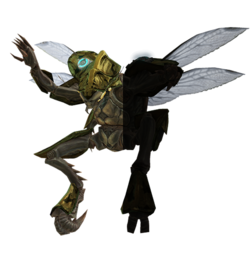
DRONE (BUGGER)
Covenant
FULL NAME: YANME'E
AFFILIATION: COVENANT
Drones (often referred to as buggers) are tall, multi-limbed arthropods. It is theorized that their generally high morale and fierceness are biochemical in nature. They are best described as irregular troops.
Elite[modifier | modifier le wikicode]
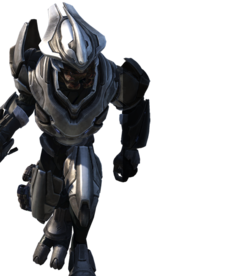
ELITE
Covenant
FULL NAME: SANGHEILI
AFFILIATION: COVENANT
Sinewy and extremely tall saurians. Following the First Battle of Harvest in 2525 this species has been observed exclusively as the leadership of the Covenant in all military engagements. They are disciplined and proficient combatants.
Brute[modifier | modifier le wikicode]
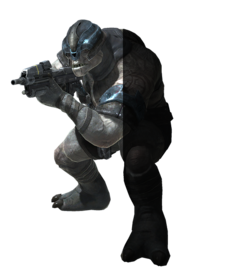
BRUTE
Covenant
FULL NAME: JIRALHANAE
AFFILIATION: COVENANT
Heavily muscled and extremely tall pseudo-ursine. Following the Harvest campaign this species has no longer been observed in any type of leadership role, being fielded primarily as heavy infantry or shock troops.
Hunters[modifier | modifier le wikicode]
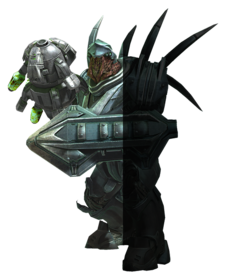
HUNTERS
Covenant
FULL NAME: MGALEKGOLO
AFFILIATION: COVENANT
More properly regarded as mechanized infantry or weapons platforms, these creatures are universally deployed in pairs (or multiple pairs) to compensate their relative lack of mobility.
Gúta[modifier | modifier le wikicode]
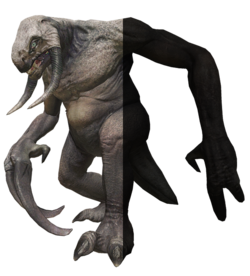
GÚTA
Neutral
FULL NAME: GÚTA
AFFILIATION: NATURAL FAUNA
The gúta is the largest terrestrial lifeform discovered on Reach. Severe aggression is rare, outside of rutting males or females with young. Even so, they are extremely dangerous animals.
Classified[modifier | modifier le wikicode]
